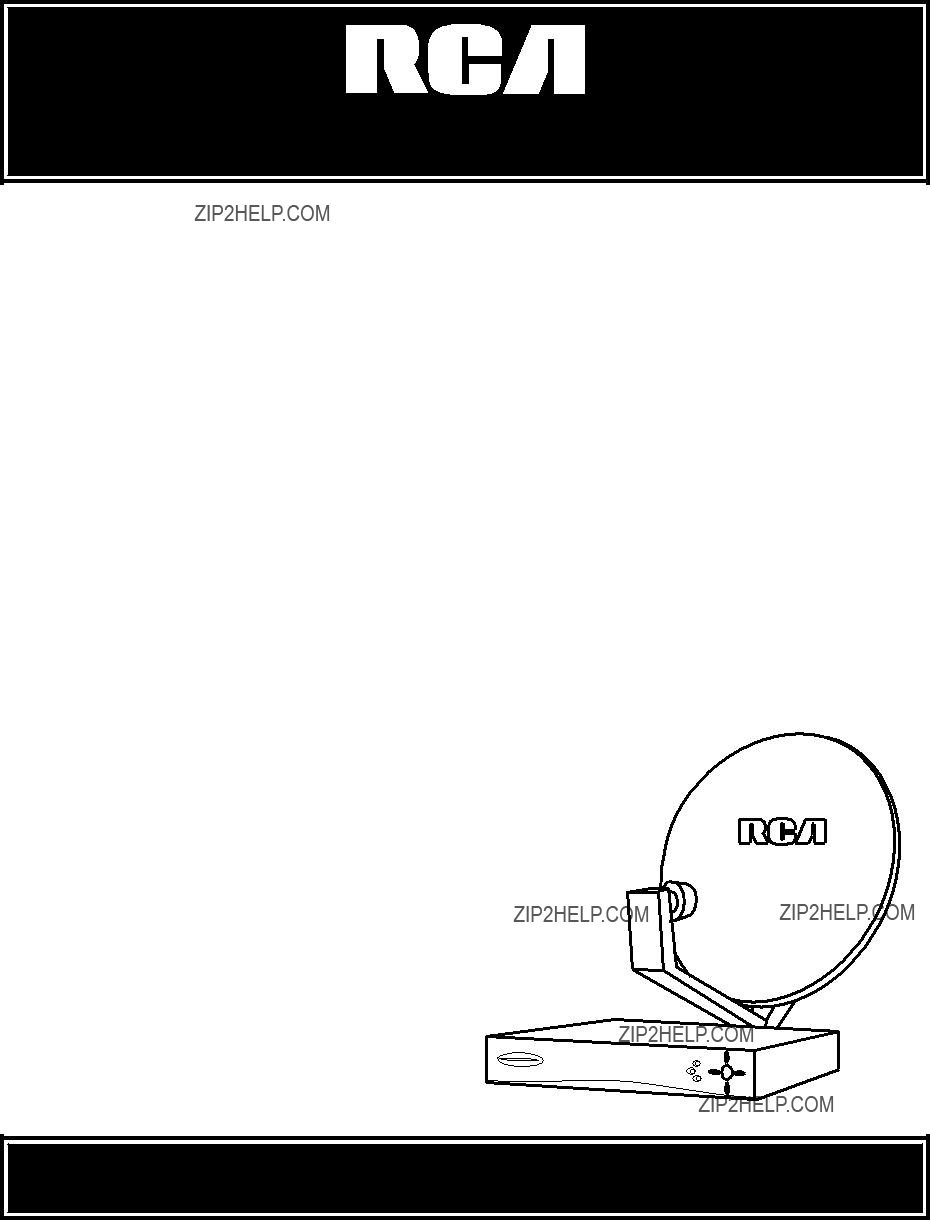
SATELLITE RECEIVER
USER'S GUIDE

SATELLITE RECEIVER
USER'S GUIDE

SAFETY INFORMATION

TABLE OF CONTENTS
1

TABLE OF CONTENTS
2
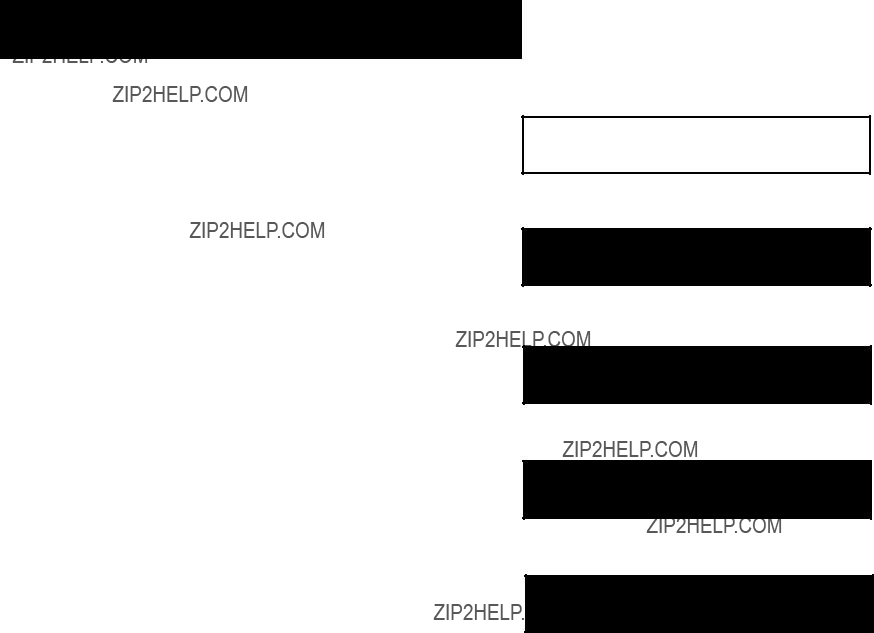
FIRST THINGS FIRST
READ THE FIRST TWO CHAPTERS
The first two chapters of the manual introduce you to your digital satellite system, and show you how to use the
In First Things First, you???ll learn:
???how to use this manual
???how to use the menu system and guides
???different ways to connect the receiver to your TV
???how to order programming
Program Guides details the items and features associated with the different guides.
THE REST OF THE MANUAL
The rest of the book includes menu information, reference information such as remote codes, a glossary, and an index.
1 FIRST THINGS FIRST
???
2 PROGRAM GUIDES
???
3 THE MENU SYSTEM
???
4 REFERENCE
???
5 APPENDICES
3

FIRST THINGS FIRST
WHAT IS THE DIGITAL SATELLITE
SYSTEM?
You???ve purchased the digital satellite system, so you already know a lot of the great things it offers. You know that the system uses the latest satellite technology to deliver television programming to your home. And you know that the transmissions are digital, so the quality of the picture and audio rivals that of laser discs and CDs. You know the dish is
Those are the some of the things you probably know about the digital satellite system. But what about the things you don???t know? For instance...
???The system works like your TV. Pick up the remote and push the SAT button. Press the Channel Up/Down buttons to scan through the channels. Press the number keys to go directly to a channel.
???There is an
???There is the
???There are three types of
System Info menu.
4
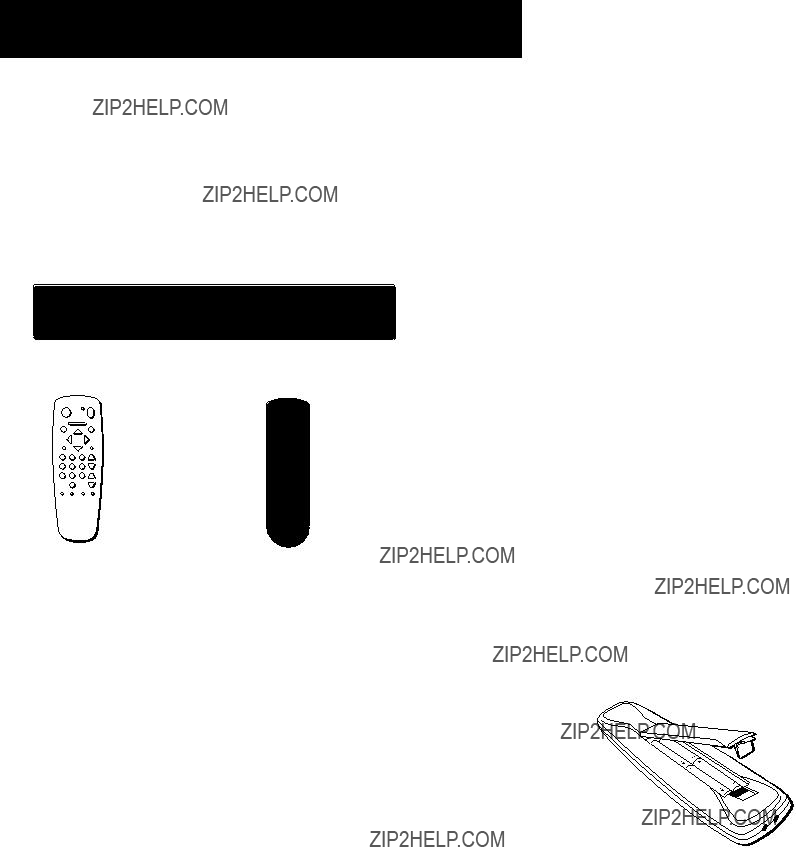
FIRST THINGS FIRST
WHAT???S IN THE BOX
The following items come with your digital satellite receiver:
???Receiver (with access card inserted)
???Remote Control (Remote controls vary by model.)
ANT WHO???INPUT ALT AUD MUTE
Receiver
DS5120RB
DRD502RB
DS5232RB
DRD523RB
Remote Control
DS5130RBC
DRD705RB
INSTALLING BATTERIES IN THE REMOTE
CONTROL
Follow these steps whenever you need to install or change the batteries in your remote.
1.Remove the cover from the battery compartment.
2.Insert batteries as shown in the battery compartment, matching the + and - end of each battery.
3.Replace the cover.
Programming the Remote
Depending on your equipment you may need to program the remote to control other devices. Check out ???Programming the Remote??? in the Reference section.
5

FIRST THINGS FIRST
USING THIS MANUAL
There are a couple of conventions used in this manual that might help you read it.
???Words that appear in ALL CAPS indicate the name of a button.
???The names of
IMPORTANT NOTE ABOUT THIS USER???S
MANUAL
This manual assumes that your digital satellite system has been installed, meaning:
1.The satellite dish antenna has been installed, correctly pointed at the satellite, and connected to your digital satellite receiver.
2.The digital satellite receiver is connected to your television and to a telephone line.
3.The access card is installed in your digital satellite receiver.
Your access card has been matched to your receiver, and should already be installed when you take the receiver out of the packing box. The access card should only be taken out of the receiver when you are issued a new card by your programming providers.
4.The remote control has batteries and can be programmed to control both your digital satellite receiver and your TV (if your TV is
If your system has not been installed, refer to the satellite dish Installer's Guide for information regarding proper installation. Then, refer to the next section, Connecting Your Receiver to Your TV. See your dealer for specific information regarding professional installation or the purchase of a
6
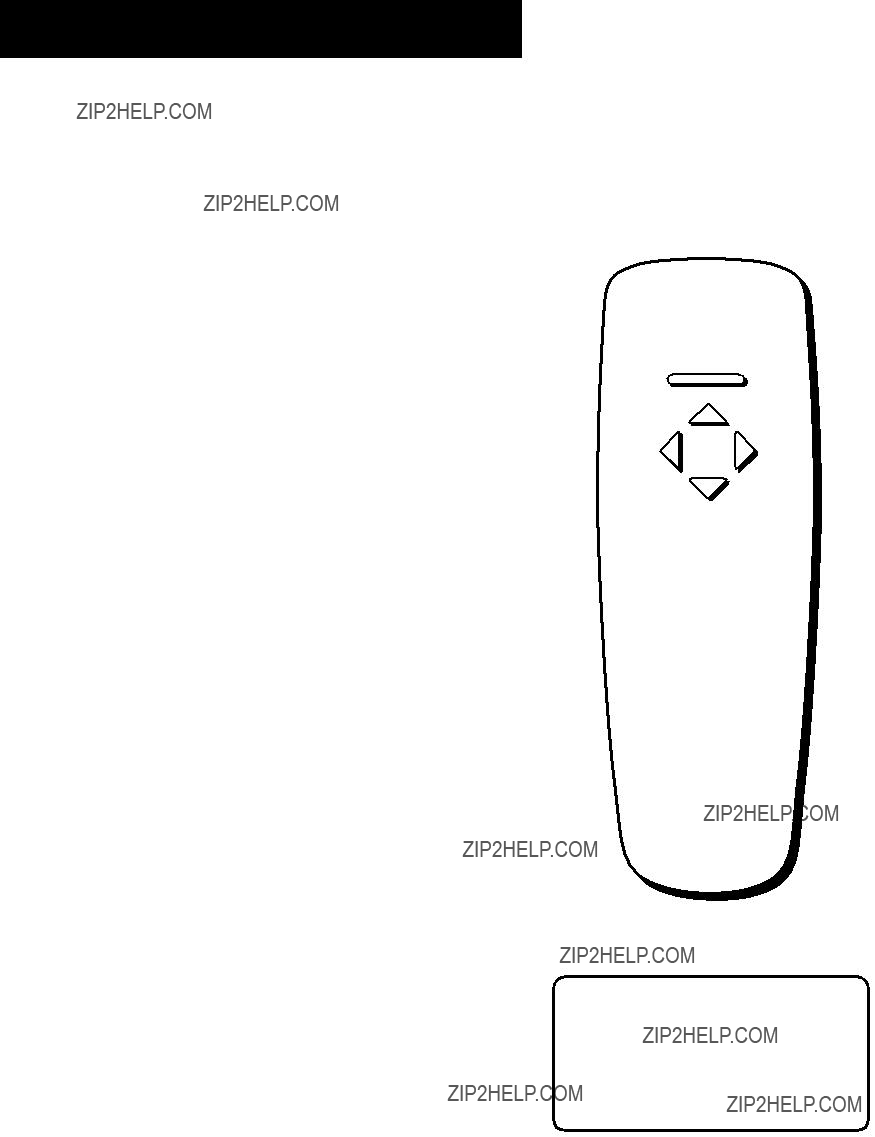
FIRST THINGS FIRST
THE POINT AND SELECT METHOD
Point and Select is the
1. POINT
You point by pressing the arrow keys on the remote or front
MENU???SELECT
panel. Pressing the arrow keys moves the
For example, to point down (that is, to move the highlight toward the bottom of the screen), press the down arrow. To point right, press the right arrow.
2. SELECT
Once you have pointed to an item on the screen, select it by pressing the MENU???SELECT button on the remote or front panel. Selecting an item tells the menu system to go ahead and make the change you have indicated.
For example, the instructions in the User???s Manual might tell you to Point to the Exit button and press MENU???SELECT.
Once you???ve got the hang of the Point and Select rule, you can use any part of the digital satellite system.
Don???t worry about getting stuck inside a menu. Pressing the CLEAR button on the remote takes you out of the menu system and back to the program you were watching.
7

FIRST THINGS FIRST
CONNECTING YOUR RECEIVER TO YOUR
TV
During the satellite dish antenna installation, the receiver may have been connected to your TV with just a coaxial cable for the system test. Depending on what components you have, another connection may provide better picture and audio quality. The following sections provide cable and connection information to help you decide what connection is best for you.
THINGS TO KNOW BEFORE CONNECTING
COMPONENTS
Protect Your Components from Power Surges
???Connect all components before plugging any power cords into the wall outlet.
???Always turn off the receiver, TV and other components before you connect or disconnect any cables.
Position Cables Correctly to Avoid Audio Hum or Interference
???Insert all cable plugs firmly into their jacks.
???Place the audio/video cables to the sides of the TV???s back panel instead of straight down the middle after you connect your components.
???Try not to coil any
???Make sure all antennas and cables are properly grounded. Refer to the Safety Tips sheet packed with your unit.
Protect Your Components from Overheating
???Do not block ventilation holes in any of the components. Arrange the components so that air can circulate freely.
???Do not stack components.
???Allow adequate ventilation when placing your components in a stand.
???Place an amplifier or receiver on the top shelf of the stand so heated air rising from it will not flow around other components.
8
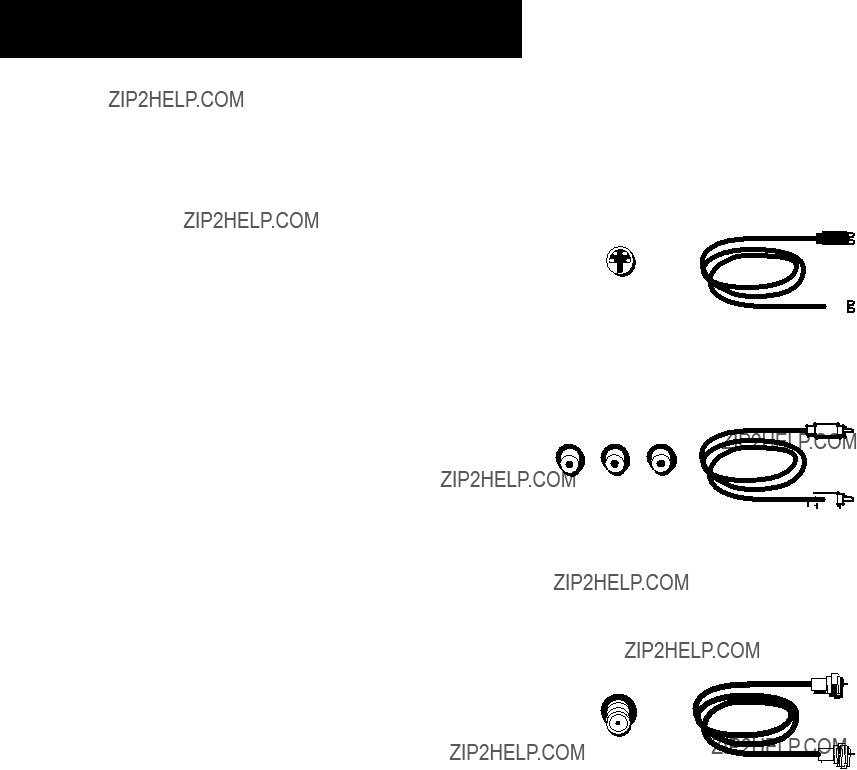
FIRST THINGS FIRST
JACKS AND CABLES
The
Audio/Video Jacks and Cables
The audio/video jacks provide very good picture and stereo sound quality, and should be used if your TV has no
RF Jacks and Coaxial Cables
The RF jacks provide good picture and mono sound quality, and are to be used if audio/video connections are not available for your TV.
9
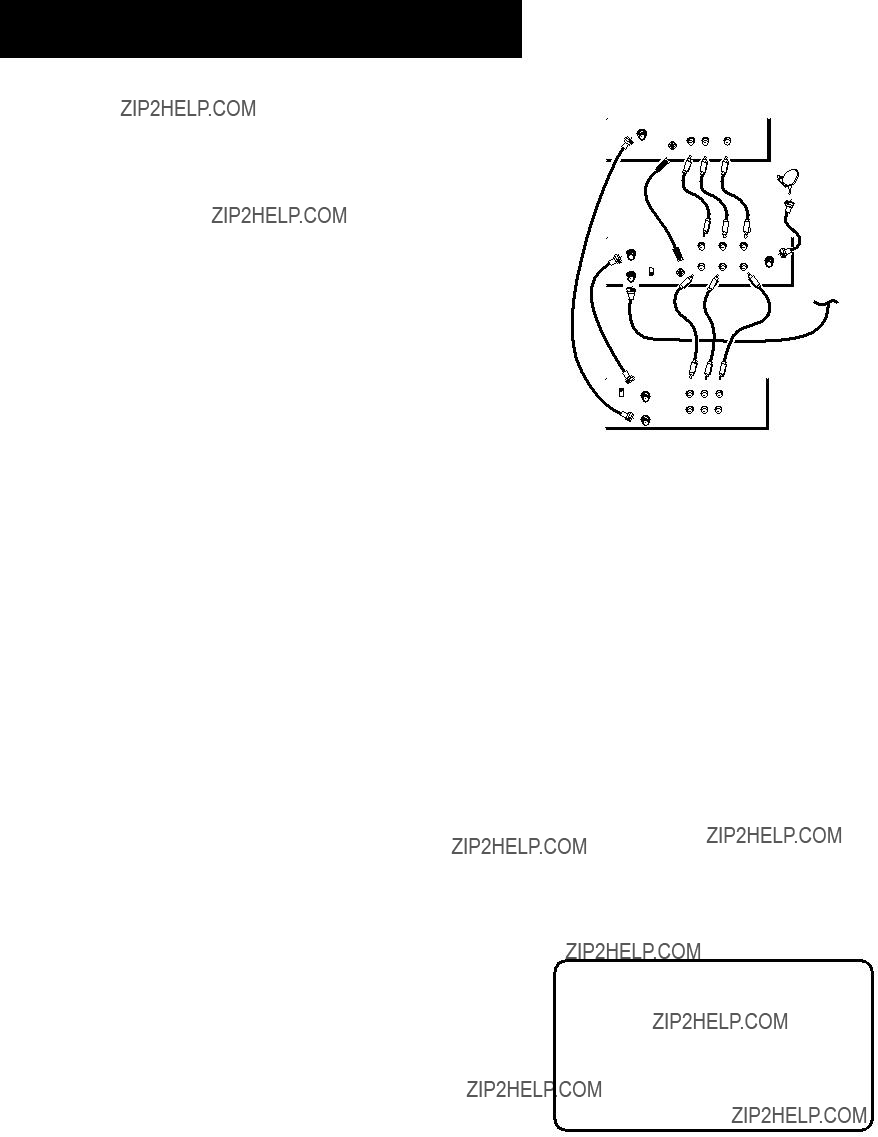
FIRST THINGS FIRST
BEST PICTURE AND SOUND QUALITY
To use this connection you must have:
DIGITAL
??? TV with separate RF, audio/video, and
RECEIVER
???VCR with RF and audio/video inputs
???Coaxial, audio/video, and
1.Connect coaxial cables as shown.
2.Connect audio/video cables as shown.
3.Connect
SATELLITE
DISH
To receive satellite programming:
1.Tune TV to receive the
2.Tune receiver to desired channel.
To receive
1.Turn off VCR and receiver.
2.Tune TV to desired channel.
To receive
1.Turn off VCR and receiver.
2.Tune TV to cable box output channel (usually CH2, CH3, or CH4).
3.Tune cable box to desired channel.
To record satellite programming:
1.Tune TV to receive
2.Tune receiver to desired channel.
3.Set your VCR to record on line input.
To view VCR programming:
1. Tune TV to VCR output channel (usually CH3 or CH4).
CAUTION
Do not stack electronic components or other objects on top of the receiver. See Safety Information, inside front cover.
10
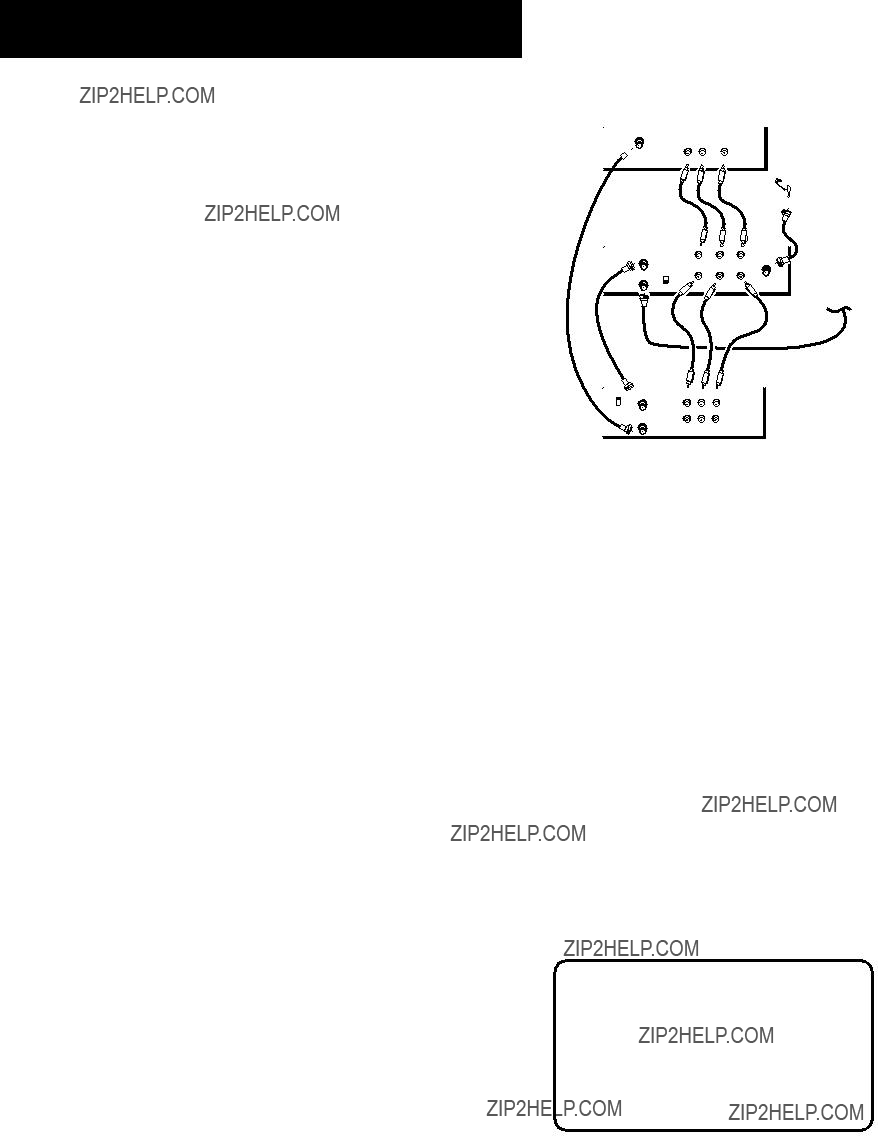
FIRST THINGS FIRST
CONNECTION B
VERY GOOD PICTURE AND SOUND QUALITY
To use this connection you must have:
???TV with separate RF and audio/video inputs (jacks)
???VCR with RF and audio/video inputs
???Coaxial and audio/video cables
TV
DIGITAL
SATELLITE
RECEIVER

 IN
IN
VIDEO R AUDIO L
 SATELLITE
SATELLITE
DISH
To connect TV, VCR and antenna or cable box:
1.Connect coaxial cables as shown.
2.Connect audio/video cables as shown.
To receive satellite programming:
1.Tune TV to receive line output from receiver (often called Input 1).
2.Tune receiver to desired channel.
To receive
1.Turn off VCR and receiver.
2.Tune TV to desired channel.
To receive
1.Turn off VCR and receiver.
2.Tune TV to cable box output channel (usually CH2, CH3, or CH4).
3.Tune cable box to desired channel.
To record satellite programming:
1.Tune TV to record line output from receiver (Input1).
2.Tune receiver to desired channel.
3.Set your VCR to record on line input.
To view VCR programming:
1. Tune TV to VCR output channel (usually CH3 or CH4).
CAUTION
Do not stack electronic components or other objects on top of the receiver. See Safety Information, inside front cover.
11
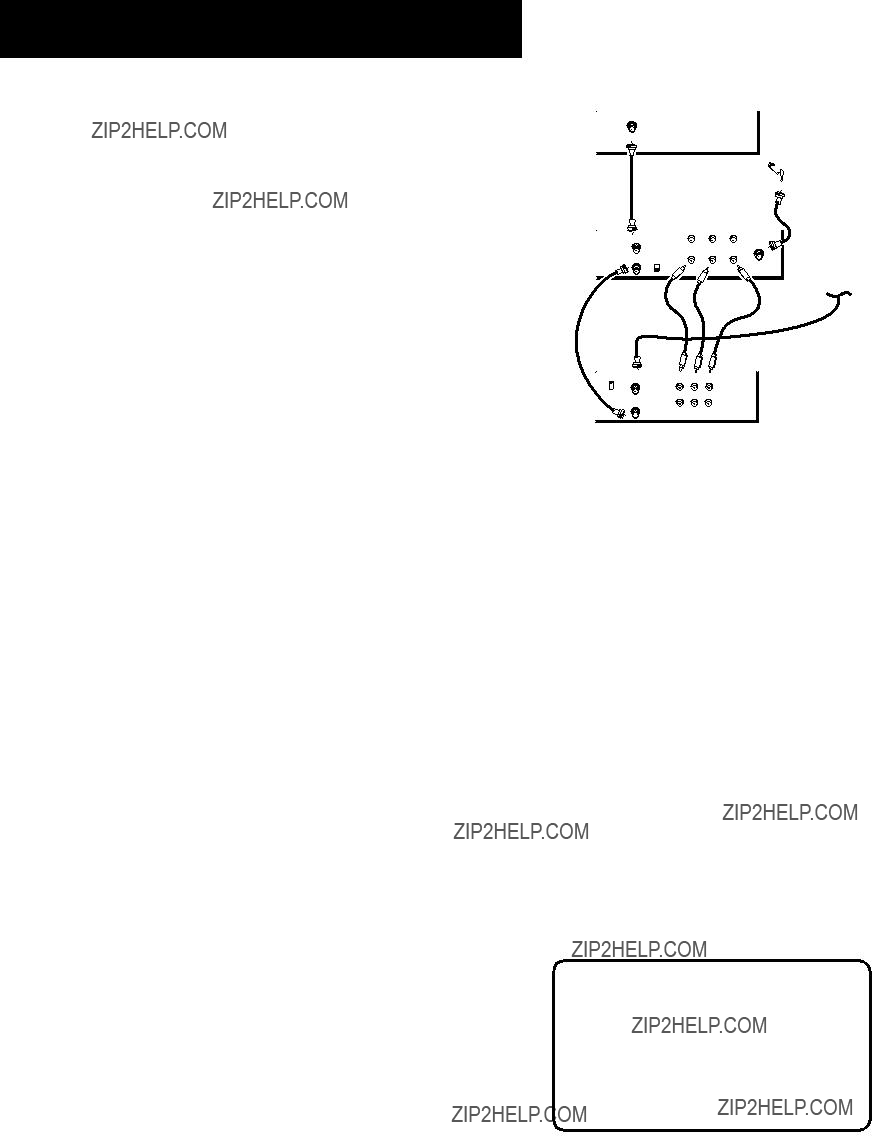
FIRST THINGS FIRST
CONNECTION C
GOOD PICTURE AND SOUND QUALITY
To use this connection you must have:
???TV with RF input (jack)
???VCR with RF and audio/video inputs
???Coaxial and audio/video cables
TV
 IN
IN
 SATELLITE
SATELLITE
DISH
To connect TV, VCR, and antenna or cable box:
1. Connect coaxial cables and audio/video cables as shown.
To receive satellite programming:
???Tune TV to channel 3 or 4 (depending on how you set the CH3/CH4 switch on the back of the receiver).
CH3
CH4
R L
OUT TO TV
VIDEO OUT AUDIO OUT
To receive
1.Turn off VCR and receiver.
2.Tune TV to desired channel.
To receive cable programming (with cable box):
1.Turn off VCR and receiver.
2.Tune TV to cable box output channel (usually CH2, CH3, or CH4).
3.Tune cable box to desired channel.
To record satellite programming:
1.Tune TV to the channel on which you receive the satellite signal.
2.Tune receiver to desired channel.
3.Set VCR to record on line input.
To view VCR programming:
1.Tune TV to VCR output channel (usually CH3 or CH4).
2.Turn receiver off.
CAUTION
Do not stack electronic components or other objects on top of the receiver. See Safety Information, inside front cover.
12
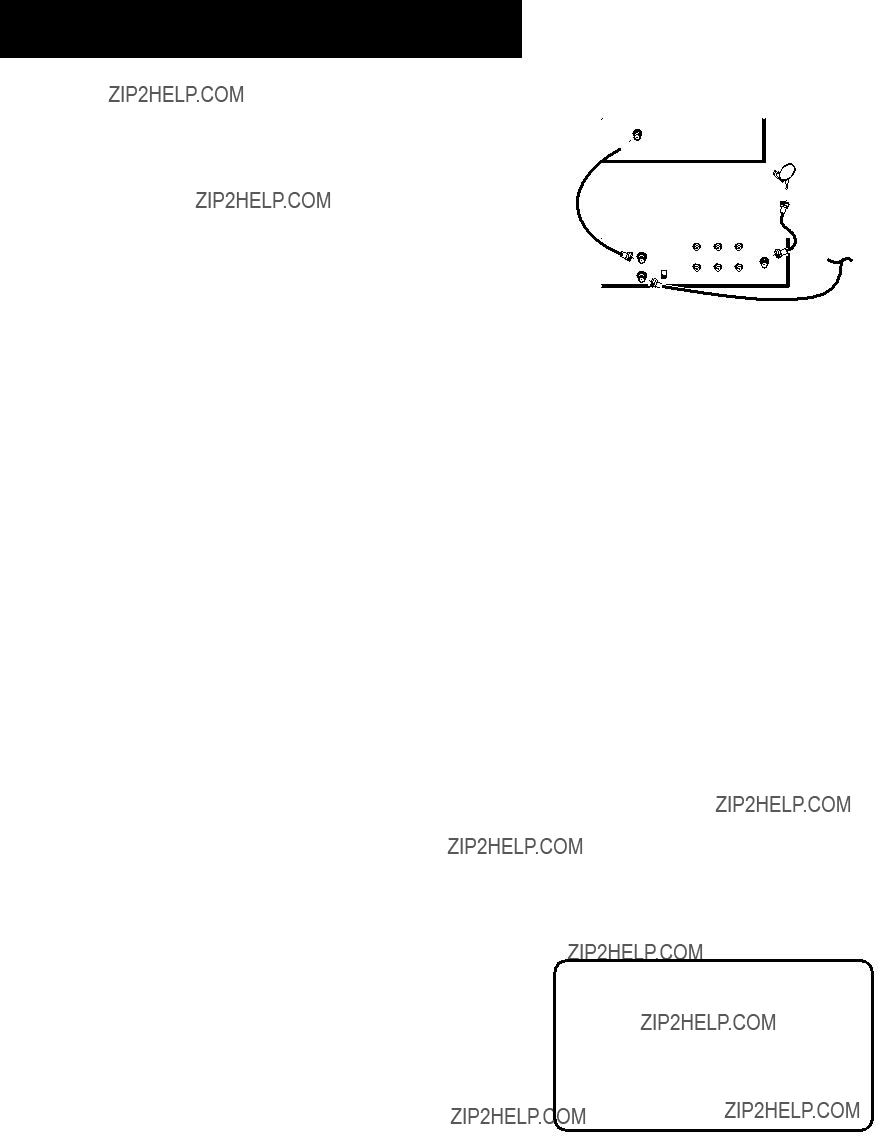
FIRST THINGS FIRST
GOOD PICTURE AND SOUND QUALITY
To use this connection you must have:
DIGITAL
??? TV with RF inputSATELLITE
RECEIVER
???Coaxial cables
To connect TV and antenna or cable box:
1. Connect coaxial cables as shown.
To receive satellite programming:
???Tune TV to channel 3 or 4 (depending on how you set the CH3/CH4 switch on the back of the receiver.

 IN
IN
To receive
1.Turn off receiver.
2.Tune TV to desired channel.
To receive cable programming (with cable box):
1.Turn off receiver.
2.Tune TV to cable box output channel (usually CH2, CH3, or CH4).
3.Tune cable box to desired channel.
CAUTION
Do not stack electronic components or other objects on top of the receiver. See Safety Information, inside front cover.
13
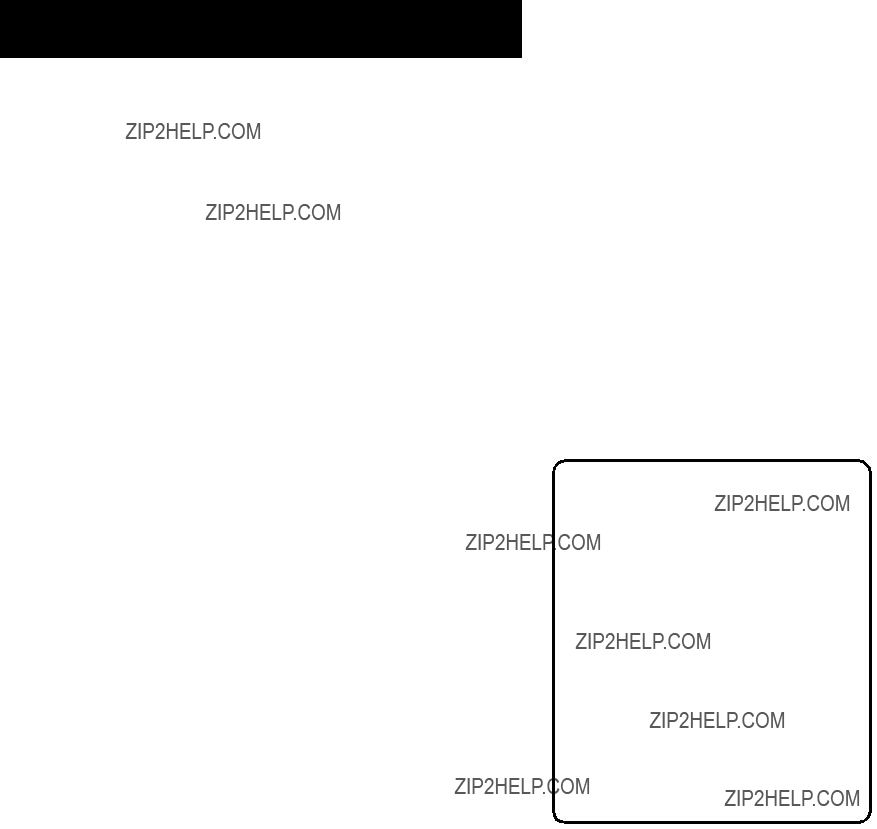
FIRST THINGS FIRST
INTERACTIVE SETUP
If you
If you need to run the interactive setup again, select Options from the Main menu, then select Interactive Setup.
If you just want to check your dish pointing coordinates, or run the signal strength meter, select Dish Pointing from the Main menu.
ORDERING SATELLITE PROGRAMMING
After you have installed your system, you should contact the service providers, DIRECTV and USSB to receive satellite programming.
When you order programming, you need to know your Access Card number. To get the number, select Options from the Main menu, then System Options, and then select System Test.
Wait for the system to run all of it???s tests. The Access Card number is displayed at the end of the system test.
Write the Access Card number in the space below for easy reference:
________________________________
14

PROGRAM GUIDES
WHAT IS A PROGRAM GUIDE?
A program guide is an
Using the program guide is easy as long as you remember the Point and Select rule. Point to items on the screen by pressing the arrow keys on the remote or front panel. Then, press MENU???SELECT to tune to that program.
1 FIRST THINGS FIRST
???
2 PROGRAM GUIDES
???
3 THE MENU SYSTEM
???
4 REFERENCE
???
5 APPENDICES
15
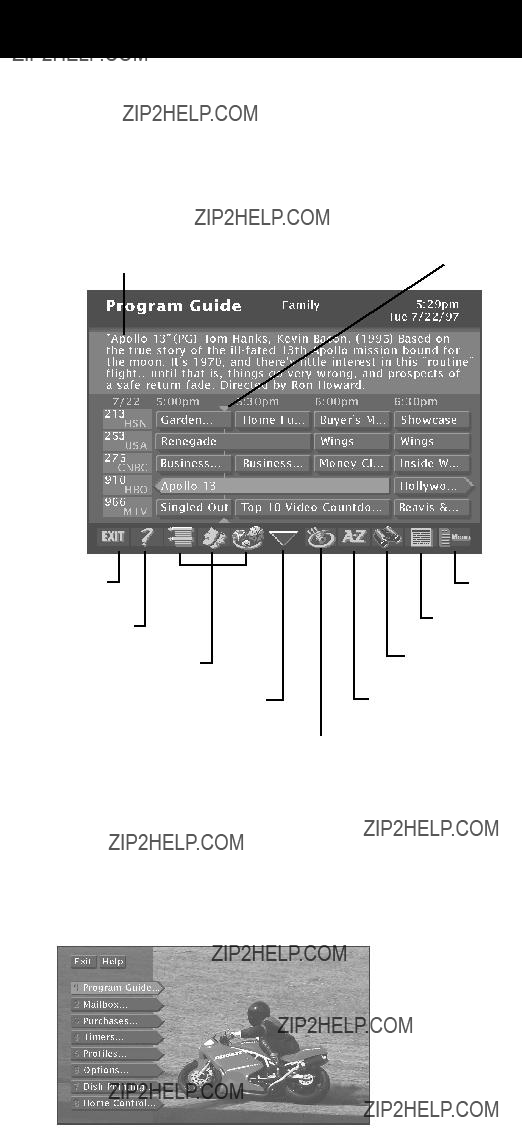
PROGRAM GUIDES
ANATOMY OF A PROGRAM GUIDE
The following diagram shows you the kind of information you will see in the program guides.
BRINGING UP THE PROGRAM GUIDES
You can access the program guides by pressing MENU???SELECT on the remote and selecting Program Guide, or by using the GUIDE button on the remote.
16

PROGRAM GUIDES
ANATOMY OF THE CHANNEL BANNER
Some of the items you select in the guides can also be selected in the channel banner.
The channel banner appears whenever you tune to a channel, exit a guide, or press INFO on the remote. Use the arrow buttons and MENU???SELECT to choose an item.
Green Unlock icon The system is unlocked. Spending, viewing and other limits can be accessed and changed.
Yellow Unlock icon A password has been entered to override family or profile limits. No limits can be accessed or changed.
Red Lock icon No limits can be accessed or changed. A password is required to override limits or access the system.
Highlighted Scout (binoculars) icon A Scout has found
program information.
Highlighted Mail icon indicates a message in your mailbox.
Home Control or Data Port icons The icon changes appearance depending on how the Low Speed Data port is used.
17
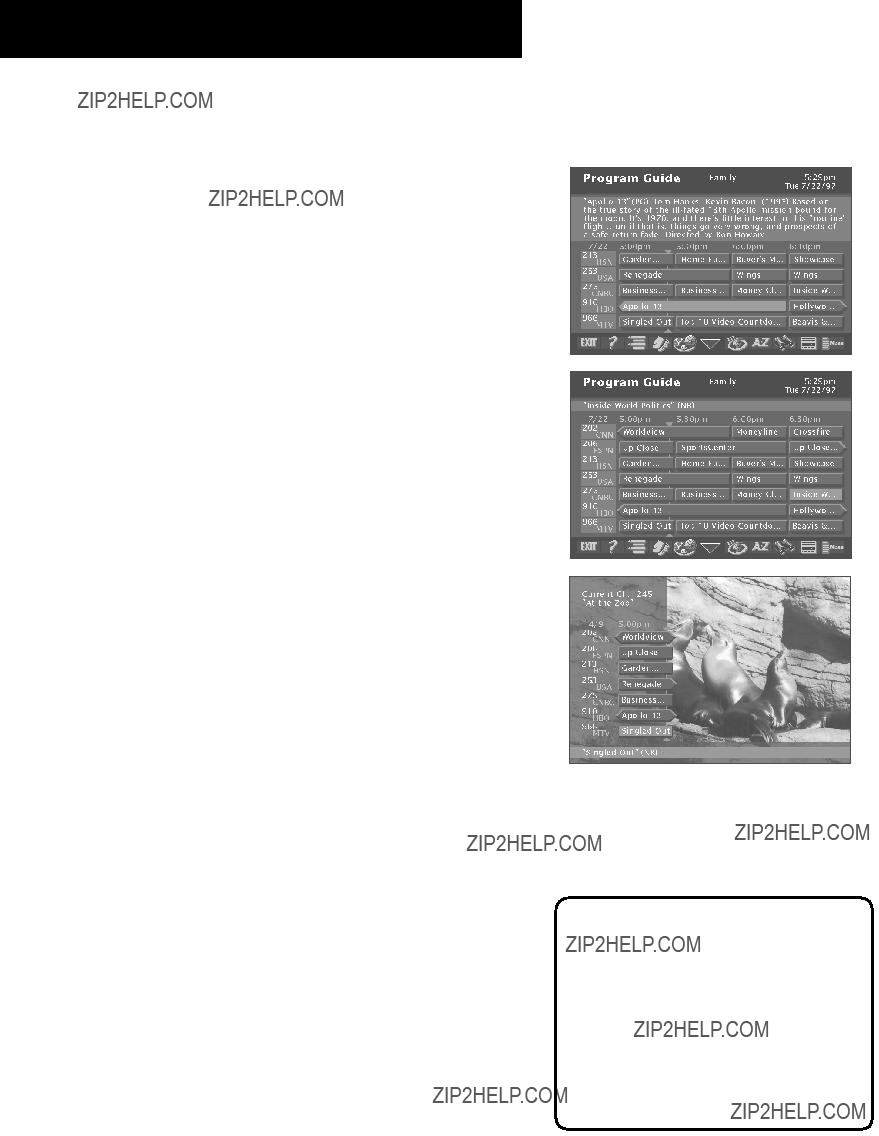
PROGRAM GUIDES
USING THE GUIDE BUTTON
Each press of the GUIDE button takes you to an alternate type of program guide.
The Detail Guide
The Detail Guide shows five channels in a
The Grid Guide
The Grid Guide shows seven channels in a
The SurfGuide
The SurfGuide displays a
GETTING AROUND IN THE GUIDES
This section describes how to change channels and move around the program guide.
Point to Channels with the number keys
You can point quickly to any channel in the program guide by entering the channel number with the number keys
Scrolling Channel By Channel
The programs that you see on the TV screen make up one
Scrolling Page By Page
If you want to scroll up or down through the program guide faster, press the Channel Up/Down buttons on the remote control. The highlight scrolls a page at a time.
By default, the Detail Guide appears when you press GUIDE on the remote. You can change the default guide from the Detail Guide to the Grid Guide or SurfGuide.
Select Options from the Main menu. Select Look and Feel, then set the Default Guide.
18
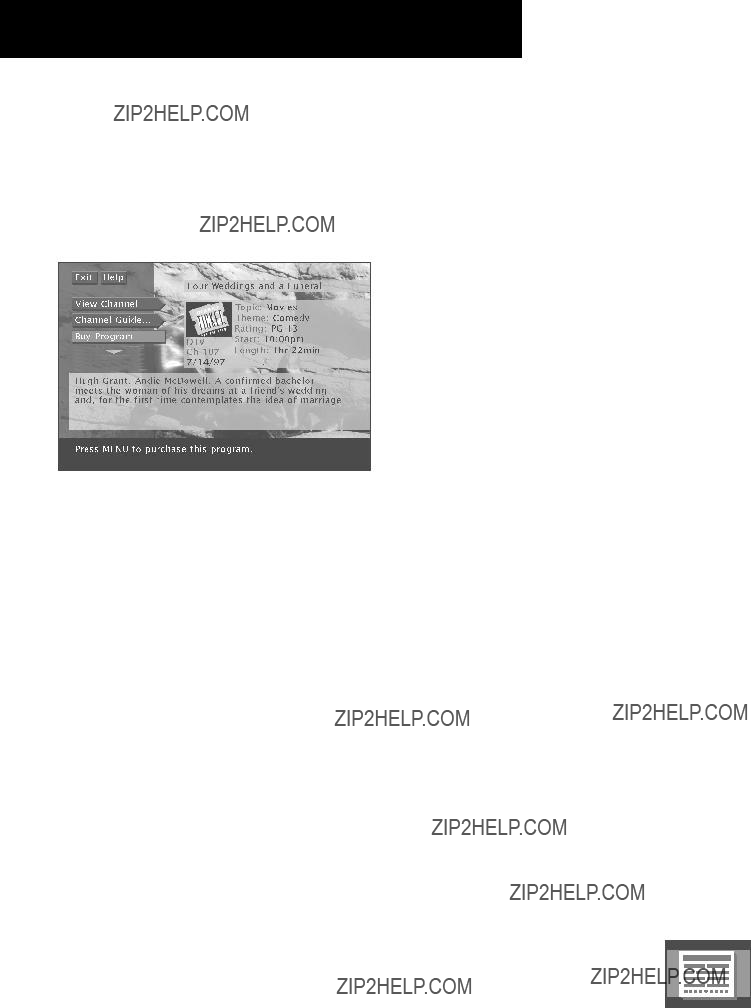
PROGRAM GUIDES
TUNING TO A PROGRAM
To tune directly to a current program listed in the guide, point to the program and press MENU???SELECT.
To see information about a program in the guide, press INFO.
The Program Details screen appears and gives you several options.
Then, you can select:
???View Channel to tune to that channel
???Channel Guide to see a program lineup for that channel
???Buy Program to purchase the program
???Other Times to see what other times the program is available. The program title is automatically entered and sorted in the AlphaSort control panel.
The options available to you may vary according to the type of program you select.
THE OTHER PROGRAM GUIDES
Besides the Detail Guide, Grid Guide, and SurfGuide, there are a few more guides: the Channel Guide, the Logo Guide and the Attractions Guide.
You can access these guides by selecting the Other Guides button at the bottom of the Detail Guide and Grid Guide.
Other Guides button
19
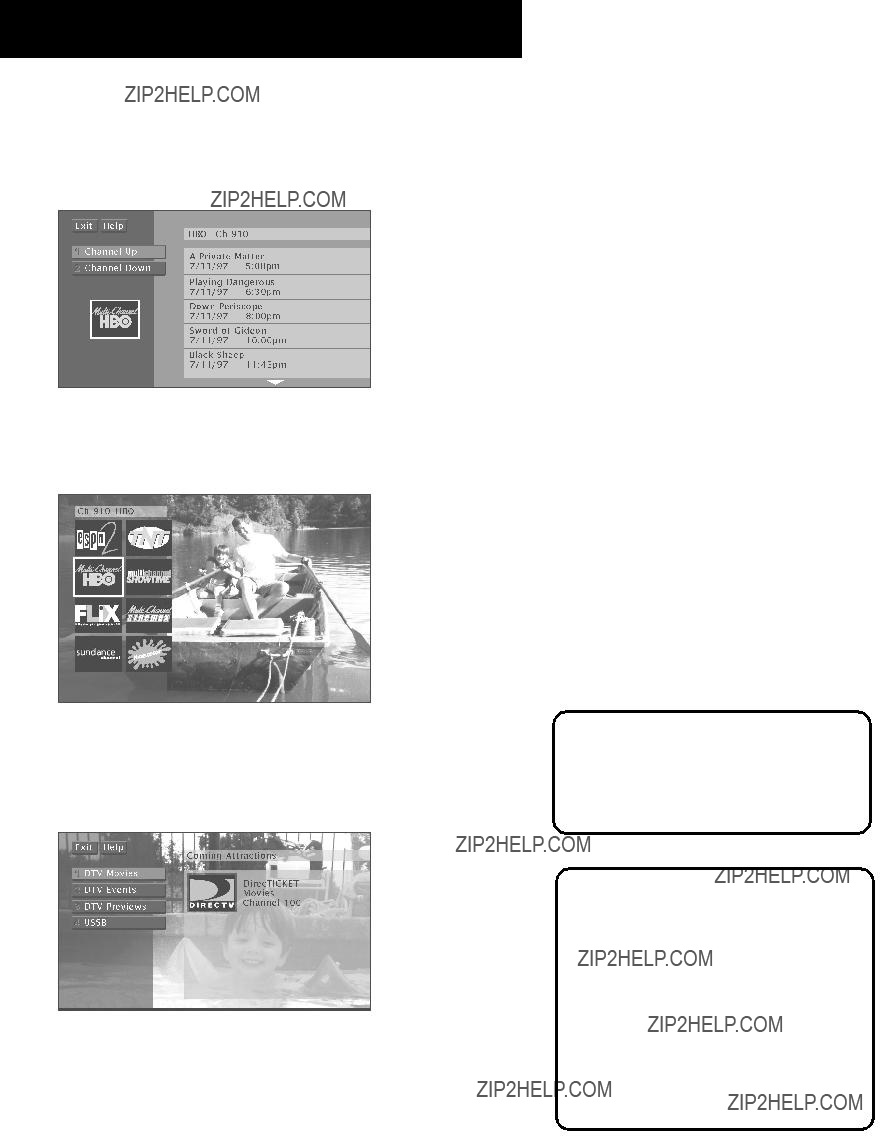
PROGRAM GUIDES
The Channel Guide
Displays a channel???s programming schedule in a
The Logo Guide
Displays channel logos for the current user???s profile.
The Attractions Guide
Displays a list of channels that show coming attractions and special events information.
You can point to any program and tune to that channel or get more information. Just press the MENU???SELECT or INFO buttons.
Exiting A Program Guide
There are three ways to exit a guide:
???Point to a channel and press
MENU???SELECT.
???Point to Exit and press
MENU???SELECT.
???Press CLEAR or GO BACK on the remote.
20
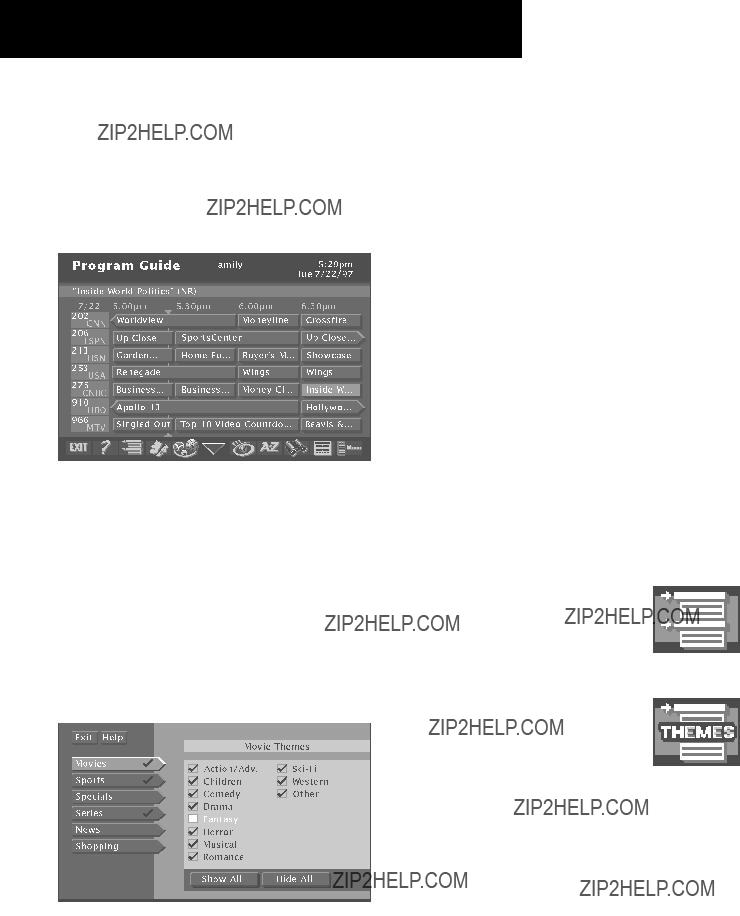
PROGRAM GUIDES
SORTING THE GUIDES
Sorting the guide is a way of organizing the guide to show only the types of programs that interest you. There are several on- screen buttons that sort the guide in different ways.
The Sorting buttons appear at the bottom of the
Grid Guide and Detail Guide.
Topics
The Topics button sorts the guide according to the current user???s preferences. Select the Topics button to sort the guide.
The Topics button changes to the Topics Themes button. Press the Topics Themes button to edit the current user???s themes preferences. These preferences are saved in each user???s profile.
Checkmark the themes that interest you.
Select the categories, and checkmark the themes you would like to appear when you select the Topics button in the guides. Programming that fits the description of checkmarked themes will appear in the guide when you sort by the Topics button.
Topics button
Topics Themes button
21
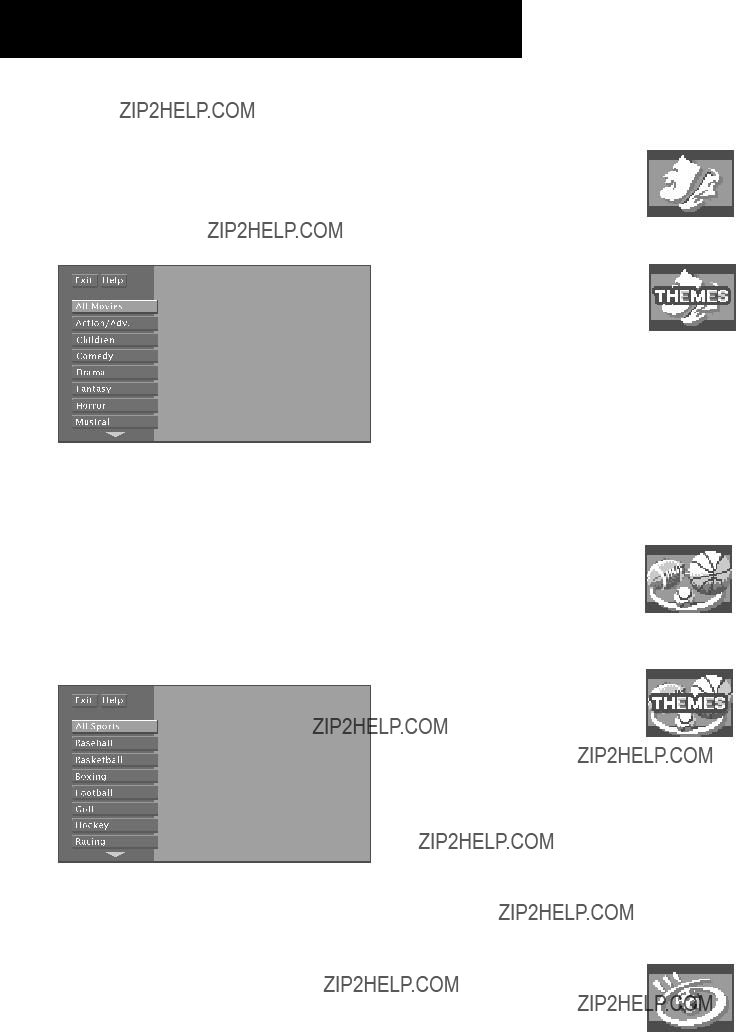
PROGRAM GUIDES
Movies
Select the Movies button to list movies only. After selecting Movies, the Movies button changes to a Movies Themes button.
Select the Movies Themes button to sort the guide to list specific types of movies, such as comedies or musicals.
Select a Movies Themes that interests you.
Sports
Select the Sports button to list sporting events only. After selecting Sports, the Sports button changes to a Sports Themes button.
Select the Sports Themes button to sort the guide to list specific types of sports, such as basketball or soccer.
Select a Sports Theme that interests you.
All
The All button resets the guide to show all available topics, channels and listings for the current Profile.
Movies button
Movies Themes button
Sports button
Sports Themes button
All button
22
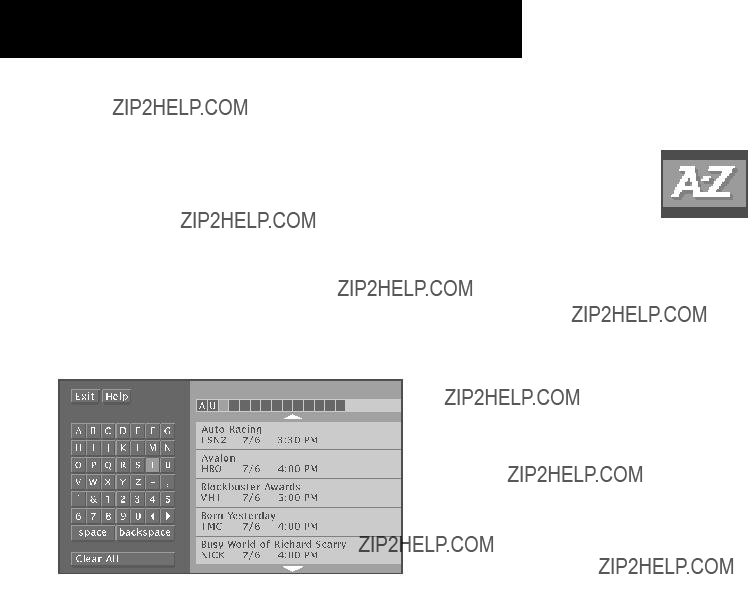
PROGRAM GUIDES
AlphaSort
AlphaSort lists in alphabetical order all the program titles in the current guide. Select the AlphaSort button to search for specific program titles that are in the current program guide. Use the arrow button to highlight a character, then press MENU???SELECT.
AlphaSort button
For example, to search for the program, Auto Racing, the first letter you should enter is ???A???. (Words like ???The???, ???A??? and ???An??? appear at the end of a title.) All titles that begin with ???A??? appear in the AlphaSort list. Next, enter the letter ???U???. All titles beginning with ???AU??? appear in the list.
AlphaSort searches for specific titles in the guide.
Continue entering the specific title???s letters until it appears in the
AlphaSort list. If you enter the wrong letter, select either
Backspace or Clear All.
Use the arrow buttons to highlight the title you are looking for. Press the MENU???SELECT button to select it, or the INFO button to see more information. Only titles that are in the current program guide can be found by AlphaSort.
23
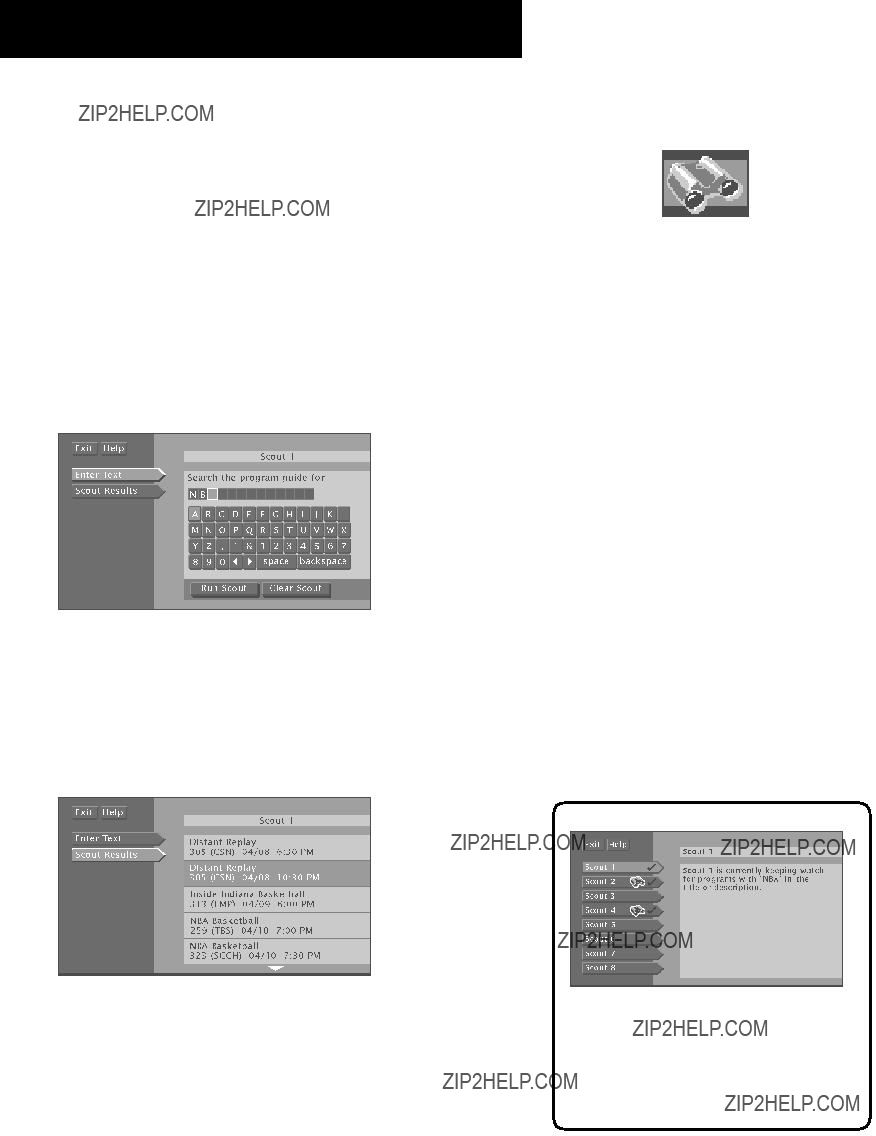
PROGRAM GUIDES
Scout
The Scout button lets you assign ???Scouts??? to search the guide for very specific program information, such as actor???s names or program descriptions. Select the Scout button to view the available scouts.
Point to an available Scout, and select it. Select the Enter Text button to set up the information the Scout will look for in the program guide. Use the
For example, if you are interested in National Basketball Association events, enter a common term you might see in program information, like ???NBA???.
Select Enter Text to set up a Scout.
If ???NBA??? appears within a program title or program description, the program will be included in the Scout Results program list.
The Scouts will search for information when the receiver is off. (This may take up to 30 minutes for a full guide search.) You can check a Scout???s results by selecting a Scout.
Scouts look for specific program information.
Use the arrow buttons to highlight the title you are looking for. Press the MENU???SELECT button to select it, or press INFO to see more information.
Scout button
A checkmark next to the Scout means it is in use.
A highlighted binocular icon means the Scout has found something.
24
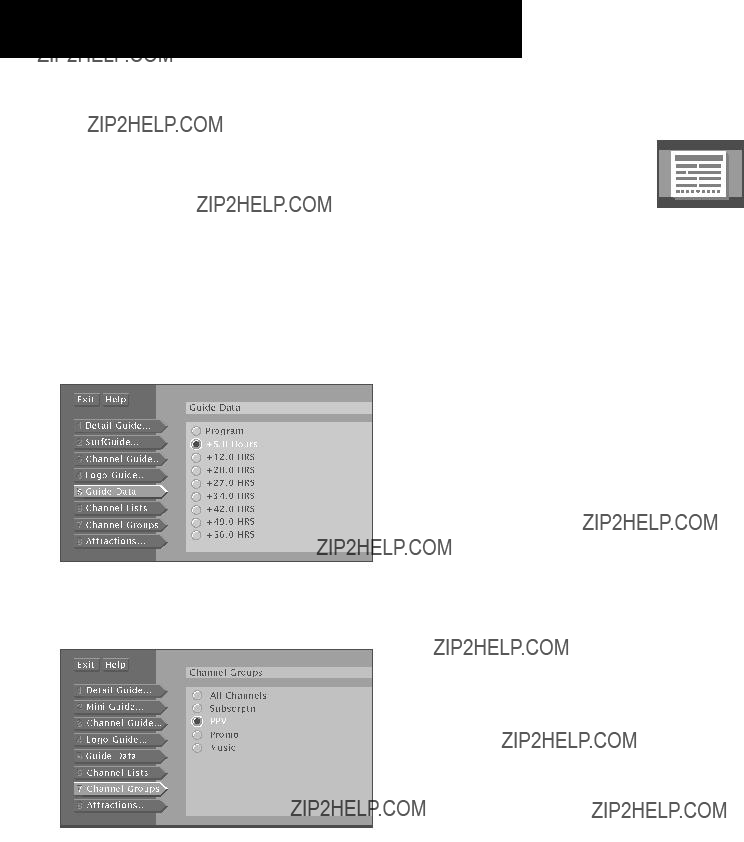
PROGRAM GUIDES
Guide Data lets you see what???s on in the future.
Then, select PPV in the Channel Groups category.
Channel Groups is another way to sort types of programming.
Select Exit, or press the GO BACK button on the remote to return to the previous guide. You can also choose another guide format from the category list.
25

PROGRAM GUIDES
The other buttons
Exit
Exits the guide and returns you to normal viewing on the current channel. Press MENU???SELECT to continue.
Exit button
Help
Brings up additional information about the guide. Press
MENU???SELECT to continue.
Help button
Down Arrow
The arrow button allows you to scroll down through other
channels in the guide. Point to the down arrow, and then pressArrow button MENU???SELECT to scroll down through the program guide.
The Main menu
Brings up the satellite system Main menu. Press MENU???SELECT to continue.
Main menu button
26
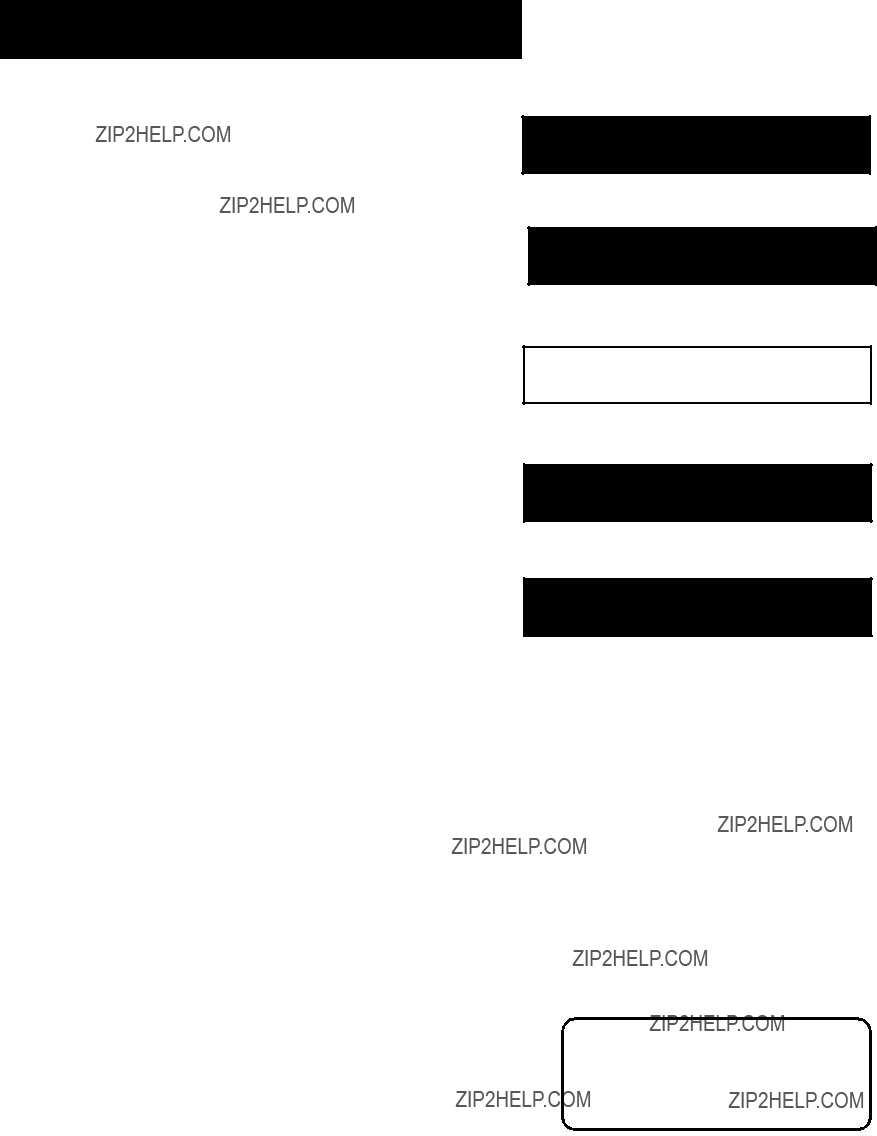
THE MENU SYSTEM
WHAT???S A MENU?
The satellite system menu is a list of choices, just like a menu in a restaurant. And, just as a restaurant menu is divided into sections such as appetizers, entrees, and desserts, the
DON???T FORGET POINT AND SELECT
As with all of the
1 FIRST THINGS FIRST
???
2 PROGRAM GUIDES
???
3 THE MENU SYSTEM
???
4 REFERENCE
???
5 APPENDICES
Use the MENU???SELECT button to bring up the Main menu, and then use Point and Select to choose a menu option.
27
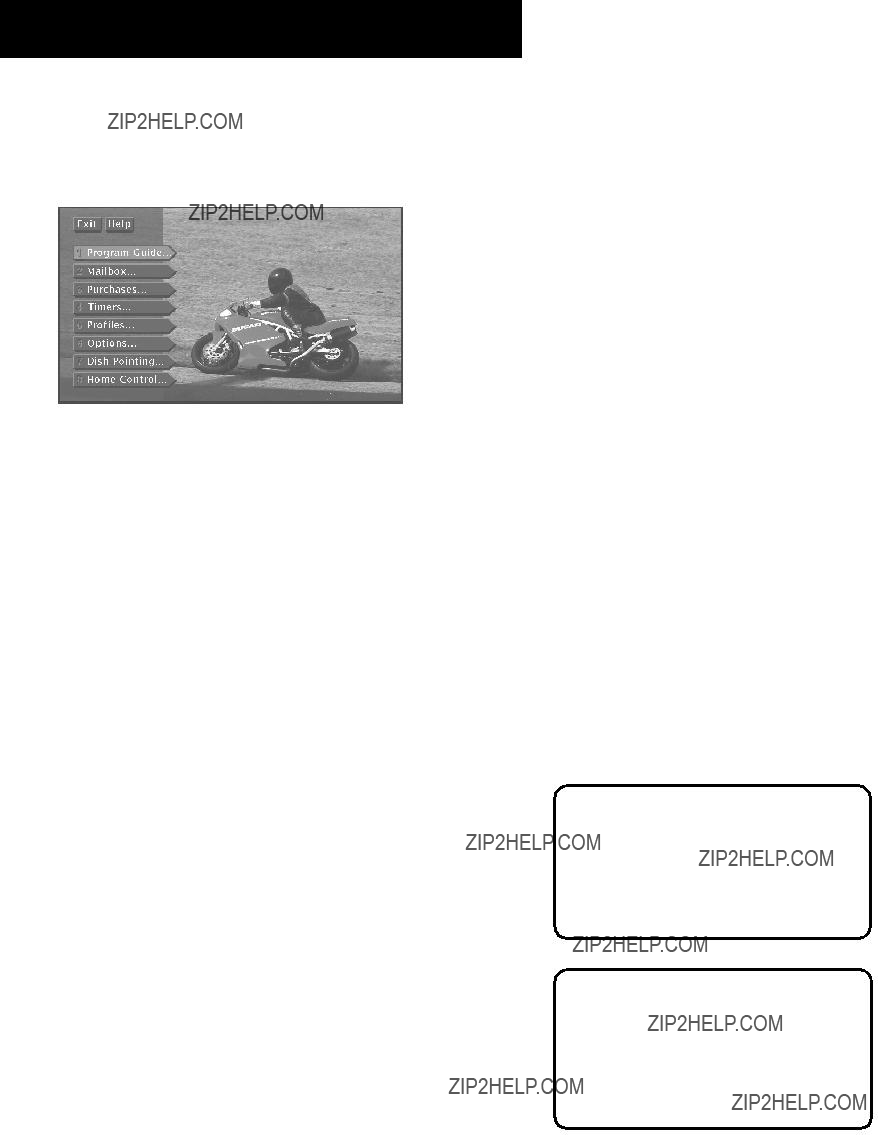
THE MENU SYSTEM
USING THE MENU SYSTEM
To bring up the Main menu, press MENU???SELECT on the remote.
Use point and select to choose an item from the
Main menu.
To use the menu system, you need to know the Point and Select rule. Use the arrows on the remote to point to an item on the screen, and then press MENU???SELECT to select it.
EXIT AND HELP
There are Exit and Help buttons at the top of most screens. Point to Exit and press MENU???SELECT to leave that screen. Point to Help to see more information about that screen.
Exiting a Screen
There are three ways to exit a menu:
???Point to Exit and press MENU???SELECT.
???Press the CLEAR button on the remote control. The
???Press the GO BACK button on the remote. You return to the previous
Using Help
All menus have a Help button. For example, selecting the Help button from the Main menu shows you information about using the Main menu screen.
The rest of the Help buttons in the menu system bring up helpful information explaining one aspect of that menu.
If the Main menu doesn???t appear when you press MENU???SELECT, the remote might not be in SAT mode. Try pressing the SAT button on the remote, and then
MENU???SELECT.
Most of the screens contain information to help you decide what to do next. If you get stuck, look for the help text.
28
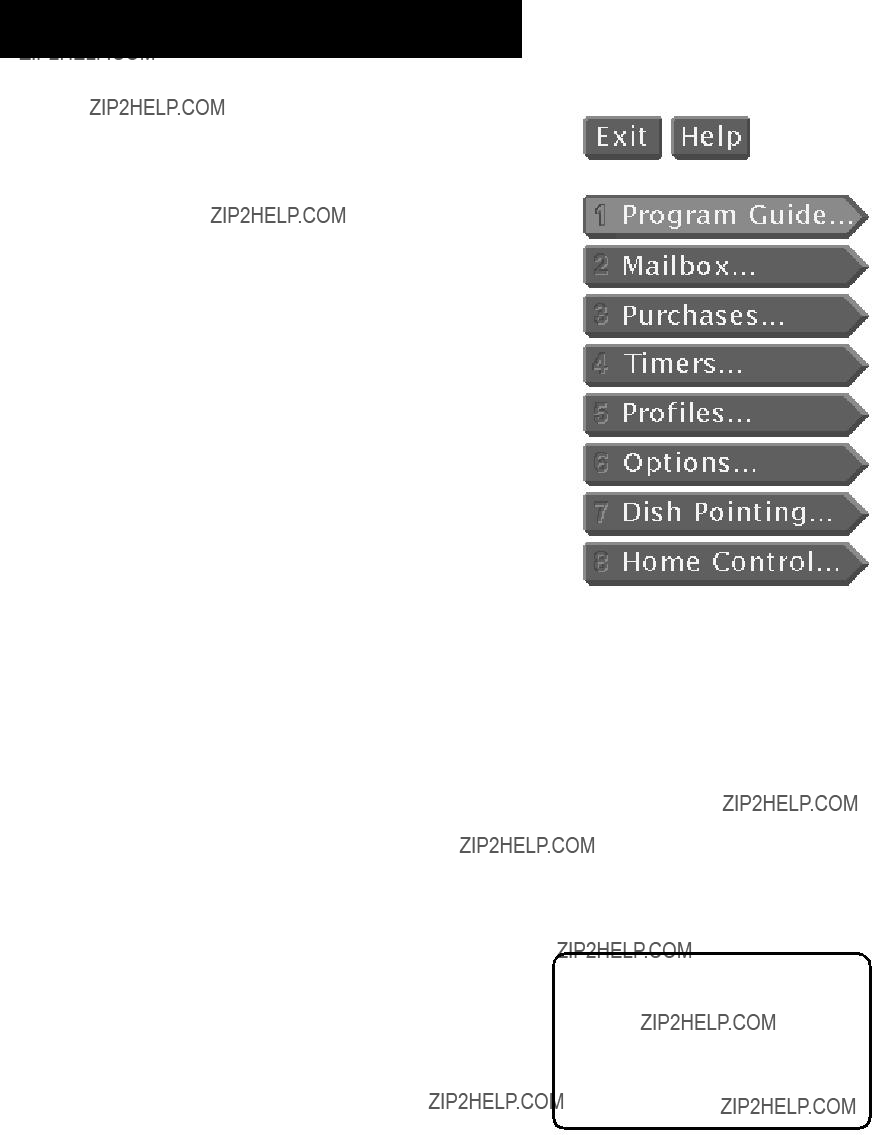
THE MENU SYSTEM
MENU DESCRIPTIONS
This section briefly describes each of the available Main menu options. More information about each menu and its features is included later in this chapter.
Program Guide
Shows the
Mailbox
Use to read mail messages from your program providers.
Purchases
Use to review or cancel upcoming purchases, and to review past purchases.
Timers
Allows you to schedule the satellite system to tune to a specific channel at a specific time.
Profiles
Allows you to set ratings limits, spending limits, and viewing hours, as well as create favorite channel lists.
Options
Allows you to find out more about the receiver and remote, change how your system looks, run the system test and install a new access card.
Dish Pointing
Use to find your dish pointing coordinates, and to access the
Home Control
With the proper equipment, this feature lets you control certain devices and appliances in your house.
DON???T BE AFRAID TO EXPLORE
Once you???ve learned the basics, feel free to poke around the menu system because exploring is the best way to learn. The
Don???t Forget about the
CLEAR button
Press the CLEAR button on the remote to remove the
29
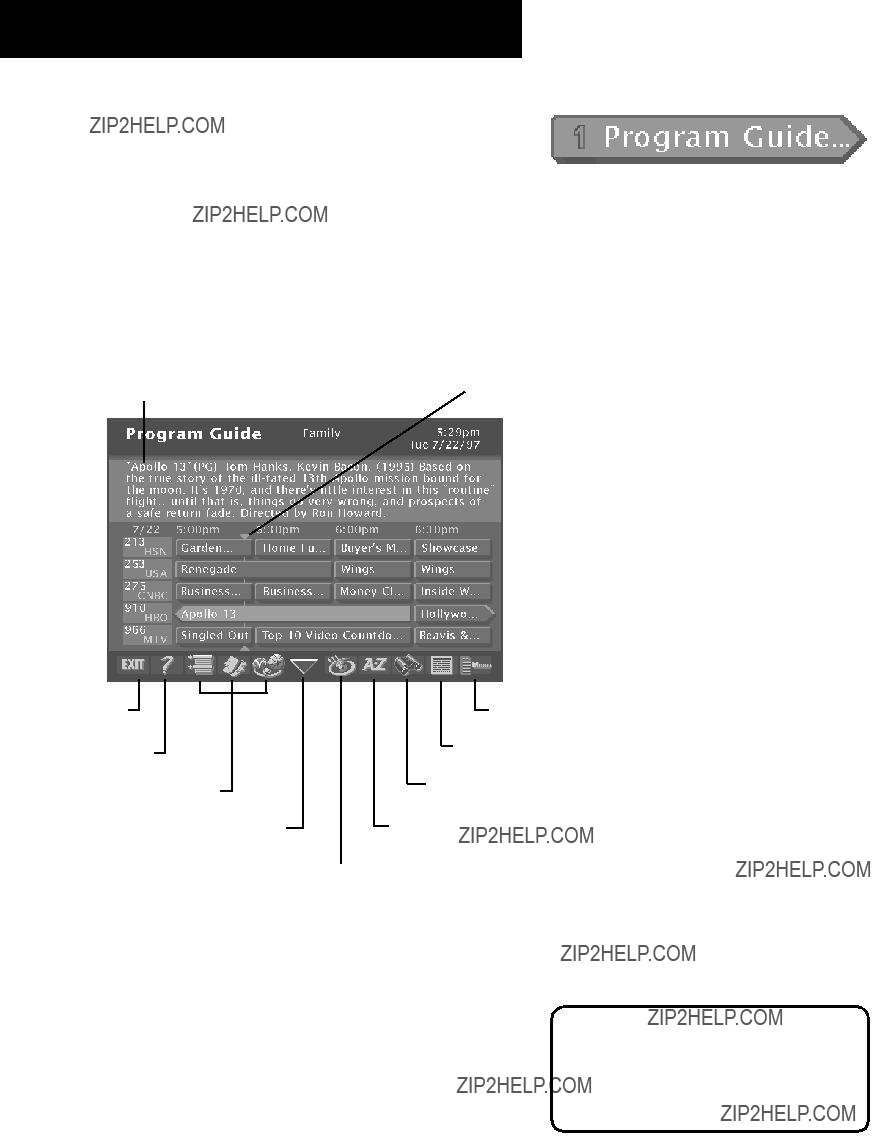
THE MENU SYSTEM
THE PROGRAM GUIDE
Selecting Program Guide brings up your default program guide: the Detail Guide, the Grid Guide or SurfGuide.
ANATOMY OF A PROGRAM GUIDE
The following diagram shows you the kind of information you will see in the Detail Guide and Grid Guide.
BRINGING UP THE PROGRAM GUIDES
Besides selecting Program Guide in the Main menu, you can press the GUIDE button on the remote.
Want More Information?
Read the chapter ???Program Guides??? earlier in this book for all the details.
30

THE MENU SYSTEM
THE MAILBOX
The mailbox shows you messages that are
HOW TO TELL WHEN YOU HAVE MAIL
There are two ways to tell if you have mail, depending on whether the receiver is turned on or off.
???If the receiver is turned on, the mail icon in the channel banner is highlighted.
???If the receiver is turned off, the power light on the front panel of the receiver flashes.
CHECKING YOUR MAIL
Select Mailbox on the Main menu or channel banner to view your mail.
1.Point to a message and press MENU???SELECT. The message is opened for you to read.
Mail provides the latest information from program providers.
2.Press MENU???SELECT again to close the letter.
After you read a message and want to erase it, point to Erase Message and press MENU???SELECT. When you exit the display screen, messages not erased are saved in memory.
31
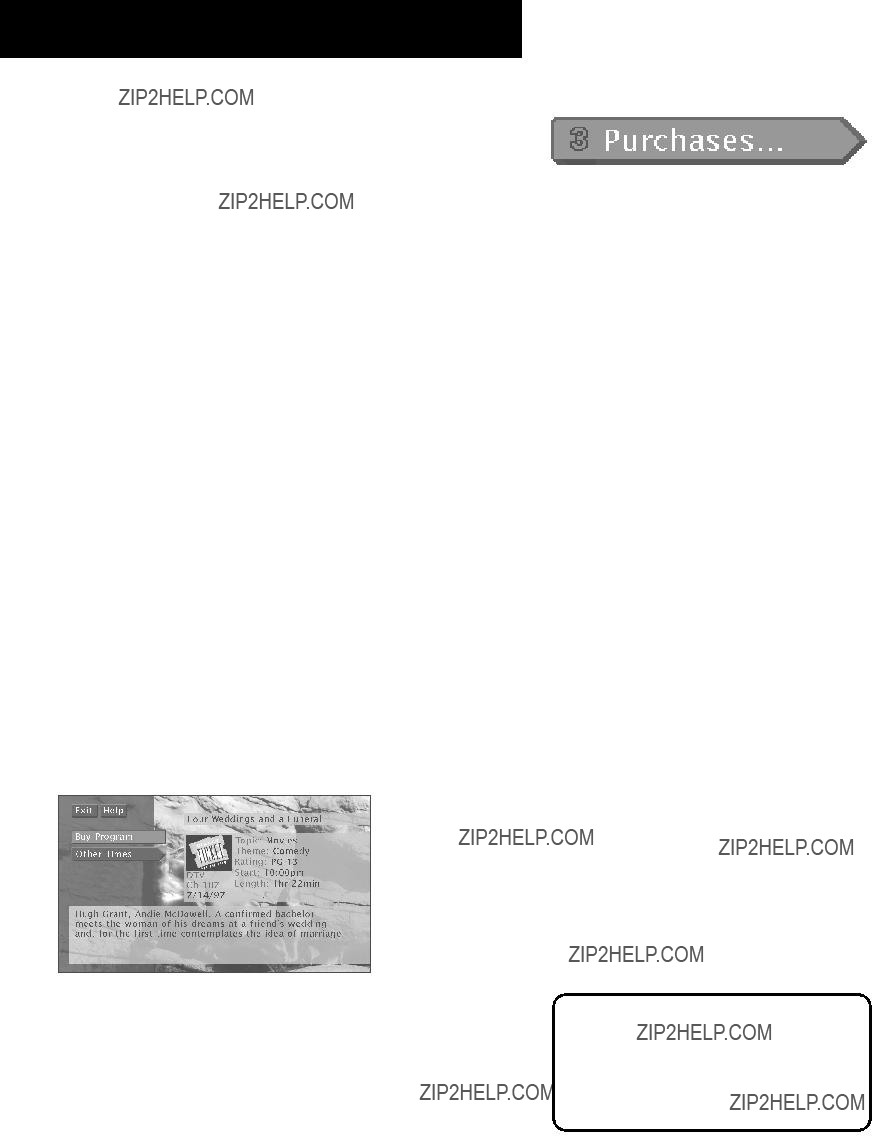
THE MENU SYSTEM
PURCHASING AND PREVIEWING
There are several ways to purchase and preview PPV movies and events:
???Tune to a PPV program???s channel. Program providers may offer
???Select a PPV program from the program guide.
???Preview a coming attraction by selecting a channel from the Attractions Guide.
TUNING TO A PPV PROGRAM
When you use the channel buttons or digits on the remote to tune to a
Use the program guide to get to the Program
Details screen.
Follow the
You may need to enter your four- digit password to order a PPV program if it costs more than the spending limit you set up in the Profiles menu.
32
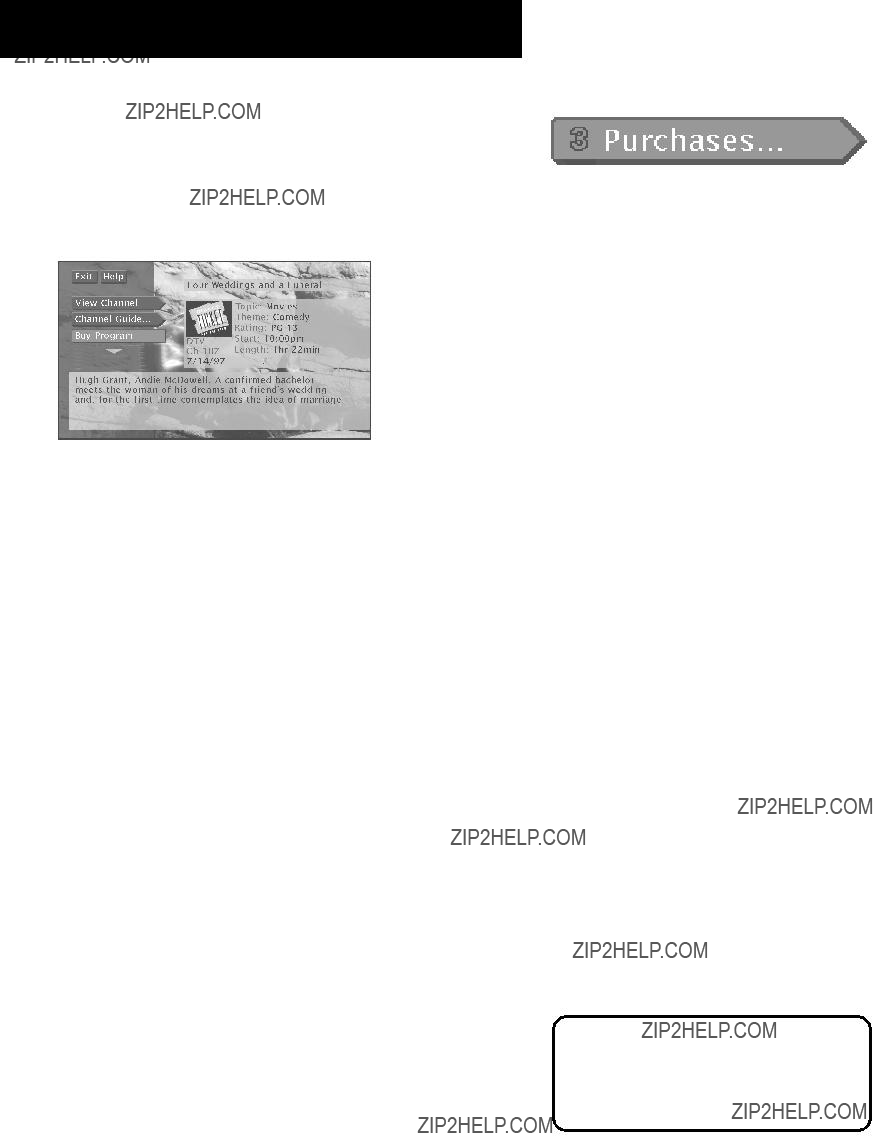
THE MENU SYSTEM
USING THE PROGRAM GUIDE FOR PPV
PROGRAMS
When you use the program guide to select a PPV program, the
Program Details screen gives you a few more options.
The Program Details screen gives you several options.
You can select:
???View Channel to tune to that channel
???Channel Guide to see a program lineup for that channel
???Buy Program to purchase the program
???Other Times to see what other times the program is available. The program title is automatically entered and sorted in the AlphaSort control panel.
The options available to you may vary according to the type of program you select.
You need to connect your phone line to your satellite receiver to be able to order PPV programs using the
33
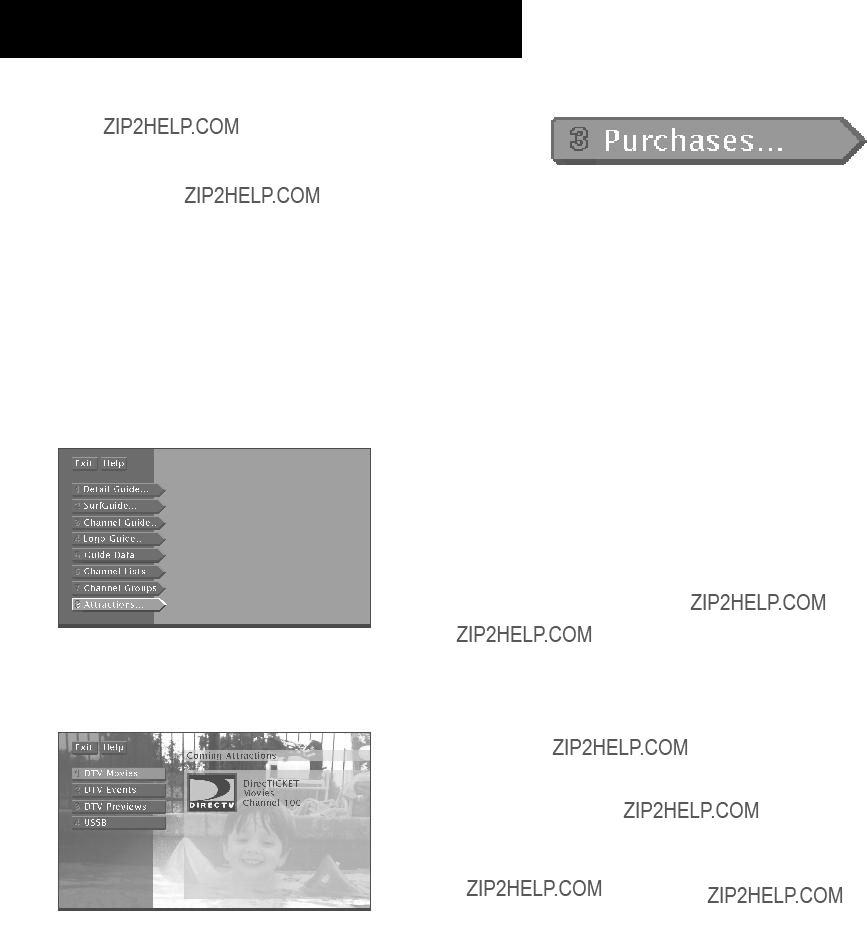
THE MENU SYSTEM
USING THE ATTRACTIONS GUIDE
Your program providers may offer future programming events not currently listed in your Program guide. These events are called ???coming attractions,??? and can be previewed in the Attractions Guide.
1.Press the GUIDE button until the Detail Guide or Grid Guide appears
2.Use the down arrow button to move the highlight to the bottom of the screen.
3.Point to and select the Other Guides button.
4.Point to and select the Attractions Guide.
The Other Guides menu provides several guide formats.
5. Point to a channel and select it.
The Attractions Guide is accessed through the
Other Guides menu.
34
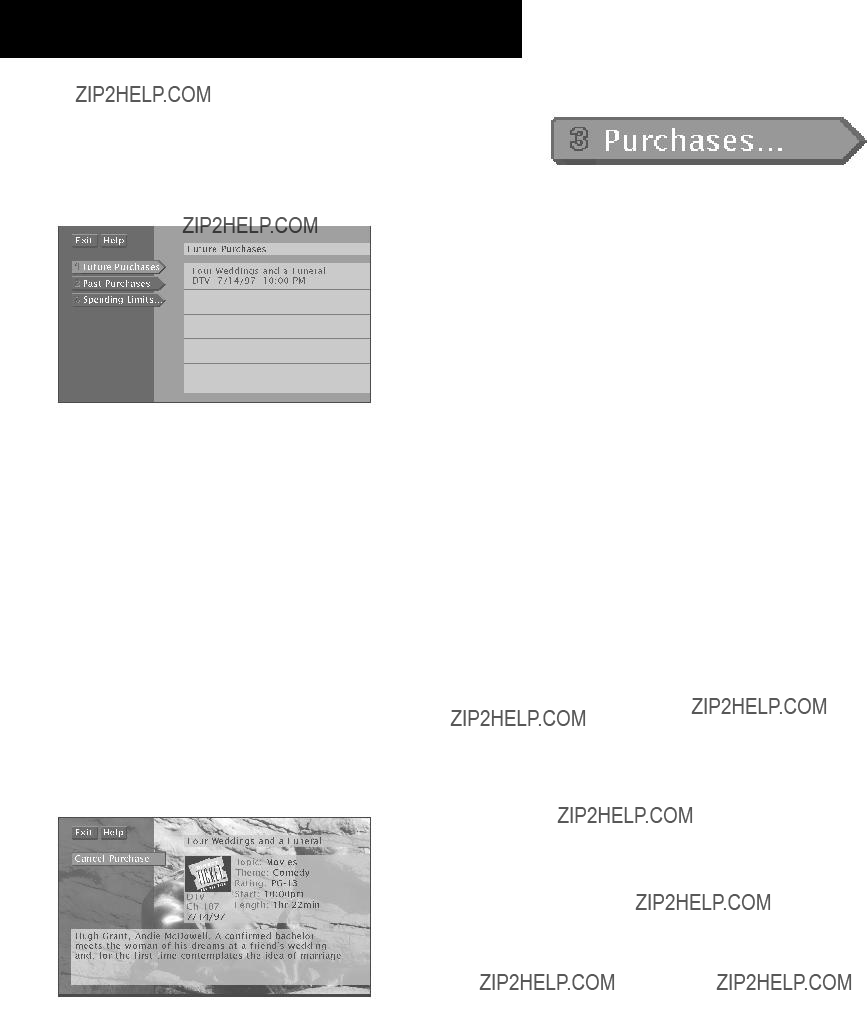
THE MENU SYSTEM
USING THE PURCHASES MENU
The Purchases menu allows you to review upcoming and past purchases.
The Purchases menu shows you upcoming or past purchases, and spending limits.
The list of purchases may be longer than one screen; use the down arrow keys to see more items. The display also shows the title, channel, date, time, and cost of each program.
???Note that the Past Purchases list might be modified after each billing cycle and still show purchases for which you have already paid.
REVIEWING AND CANCELING AN
UPCOMING PURCHASE
Use Point and Select to choose an upcoming purchase from the Future Purchases screen. You can review the program description, as well as cancel an upcoming purchase.
The Purchase Edit screen lets you cancel an upcoming purchase.
35
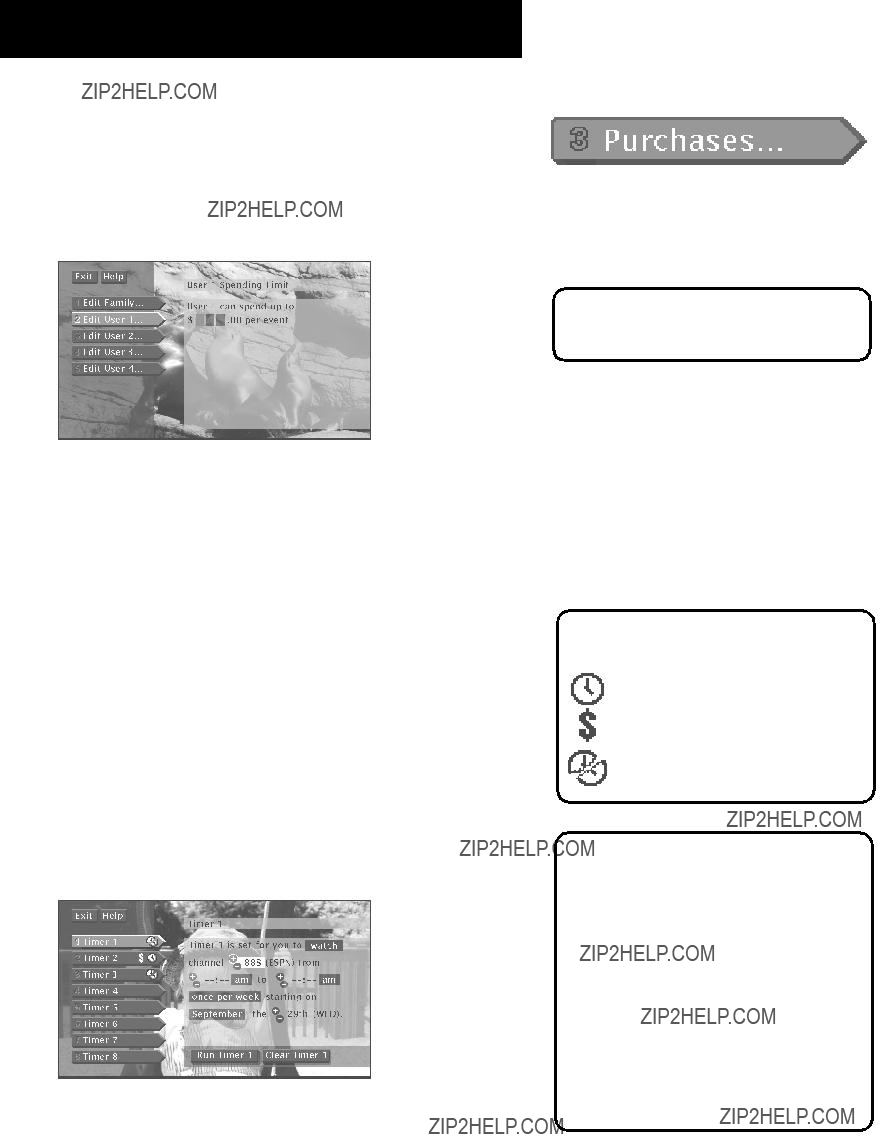
THE MENU SYSTEM
SPENDING LIMITS
Use the Spending Limit option to indicate a
1. Point to Spending Limit, and press MENU???SELECT.
You can set a
Profile.
2.Use the digits on the remote or use the arrow keys to enter a
After a spending limit is set and the system is locked, you must enter a password to purchase a
TIMERS FEATURE
The Timers feature allows you to preset your system to automatically tune to a particular channel at a predetermined time.
To use the Timers feature, select Timers from the Main menu to bring up the Timers screen. Select a Timer
Complete the
Spending limits are in effect only when the system is locked.
indicates the timer is set.
indicates the timer is set for a PPV.
indicates a timer conflict.
Editing or Canceling a Timer
From the Timers screen, select the Timer you want to edit or cancel, and then do the following:
???Use the arrows keys to edit the Timer, then select Run Timer.
???Select Clear Timer to cancel the timer.
???To watch the program daily or weekly, edit that program???s timer.
36
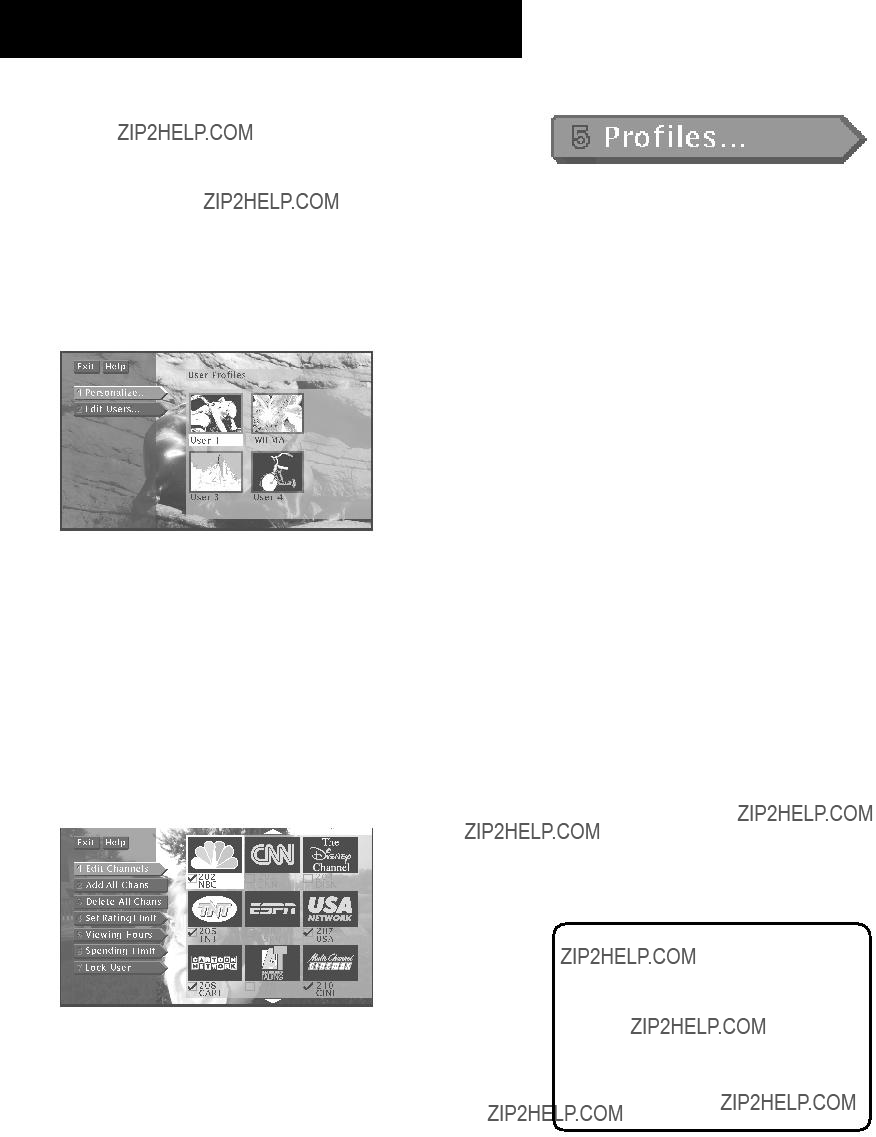
THE MENU SYSTEM
PROFILES
When you select Profiles from the Main menu, the first screen you see is the User Profiles control panel. In addition to the Family profile, you can create as many as four different profiles that can be easily accessed by using the WHO???INPUT button on the remote control.
You can personalize how the profile looks
You can personalize each profile.
You can also edit the user profiles. Select a profile from the Edit Users control panel. By moving down the options you can create or edit the user???s channel list, set a ratings limit, viewing hours,
CREATING A PROFILE CHANNEL LIST
1.Point to and select Edit Users, then choose a user.
2.Point to a channel list option and press MENU???SELECT.
To start, you can add or delete all channels.
3.Use the arrow keys to point to a channel, and press MENU???SELECT to remove (or replace) the checkmark. Checkmarked items appear in the channel list.
You need to lock the system in order for rating limits, channel limits, viewing hours, and spending limits to go into effect.
After you lock the system, you need to enter the system password to edit the limits. See
???Locking the System??? for details
37
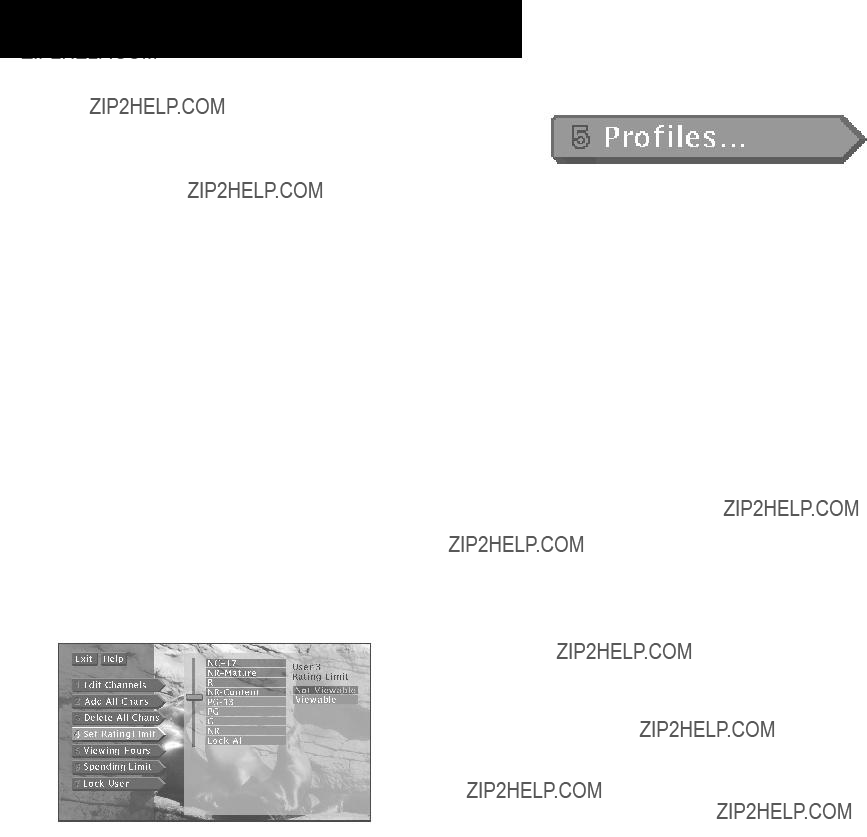
THE MENU SYSTEM
Add or Delete All Channels
You might be able to save time when creating a channel list by using the Add All Chans option or the Delete All Chans option to either add all channels or delete all channels before removing or adding individual channels.
Also, program providers may make additional channels available. To prevent new channels from appearing in a profile channel list, choose Delete All Chans and checkmark only the channels you want to appear in the list.
SETTING THE RATINGS LIMIT
The Ratings Limit menu enables you to set a maximum viewing limit for rated movies (based on the MPAA ratings system), as long as the program provider has transmitted the proper code.
???Note that the ratings limit cannot be enforced if a program has not been rated, if rating information for that program is not transmitted by the program provider, or if the system has not been locked.
1. Point to Set Rating Limit and press MENU???SELECT.
Use the arrow keys to move the selector up and down.
2.Use the up and down arrows to move the rating selector to the highest rating you want to be able to view. In the preceding illustration, movies that are rated up to and including a
After the Rating Limit is set and the system is locked, you must enter the system password to watch programs with a rating higher than your limit.
38
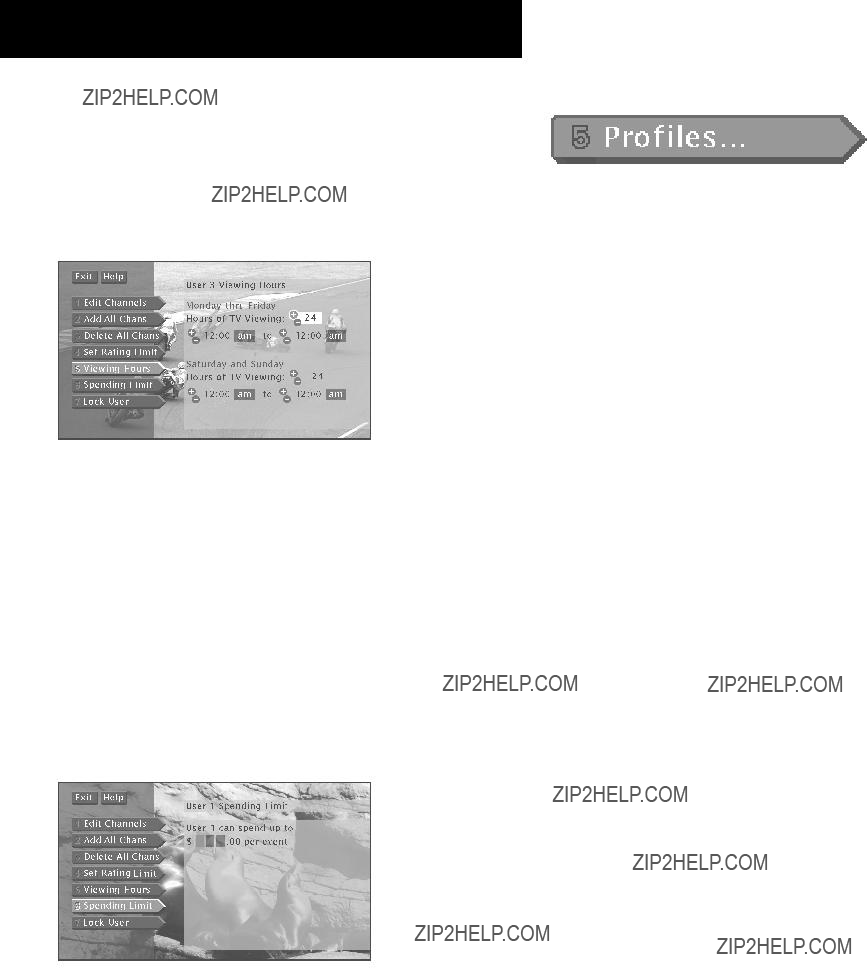
THE MENU SYSTEM
VIEWING HOURS
Use the Viewing Hours option to limit the total amount of time, as well as the viewing hours a user can watch programming.
1. Point to Viewing Hours, and press MENU???SELECT.
You can limit viewing seven days a week.
2.Use the digits on the remote or point to the + or ??? and press MENU???SELECT to complete the
SETTING UP SPENDING LIMITS
Select the Spending Limit option to indicate a
1. Point to Spending Limit, and press MENU???SELECT.
You can set a
2.Use the digits on the remote or use the arrow keys to enter a
After a Spending Limit is set and the system is locked, you must enter the system password to purchase a
39
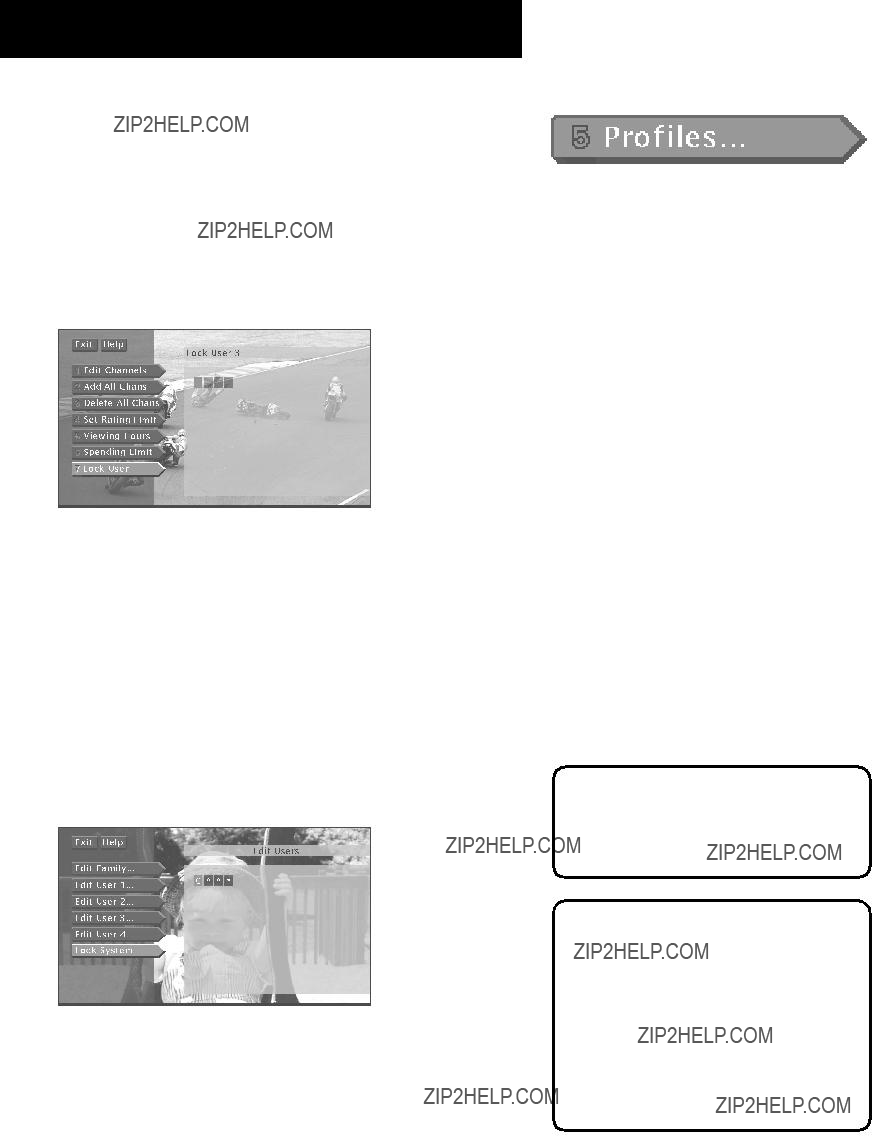
THE MENU SYSTEM
LOCKING A USER???S PROFILE
Each user can be assigned a personal password to lock his or her profile. When a password is assigned, the user must enter the password before he or she can view programs using that profile. Profile passwords do no allow access to, or editing of the profile limits. You must enter the system password to edit profile limits.
1. Point to Lock User and press MENU???SELECT.
Each user can have a password.
2.Use the arrow or digit keys to select each number of the password.
LOCKING THE SYSTEM
You can lock the system in order to put into effect the ratings, spending, viewing, and channel limits you have set up. When you lock the system, no one can modify any of these settings without first entering the
1. Point to Lock System and press MENU???SELECT.
Locking the system protects the limits you set up.
2.Use the arrows or the digit keys to enter a
3.Enter the password a second time to confirm it.
After the system has been locked, you must enter the correct password in order to access the Edit Users control panel.
Don???t Forget Your Password
If you forget a USER password, you need to unlock the system and then assign a new user password.
If you forget the SYSTEM password, contact your program provider???s authorization center.
40
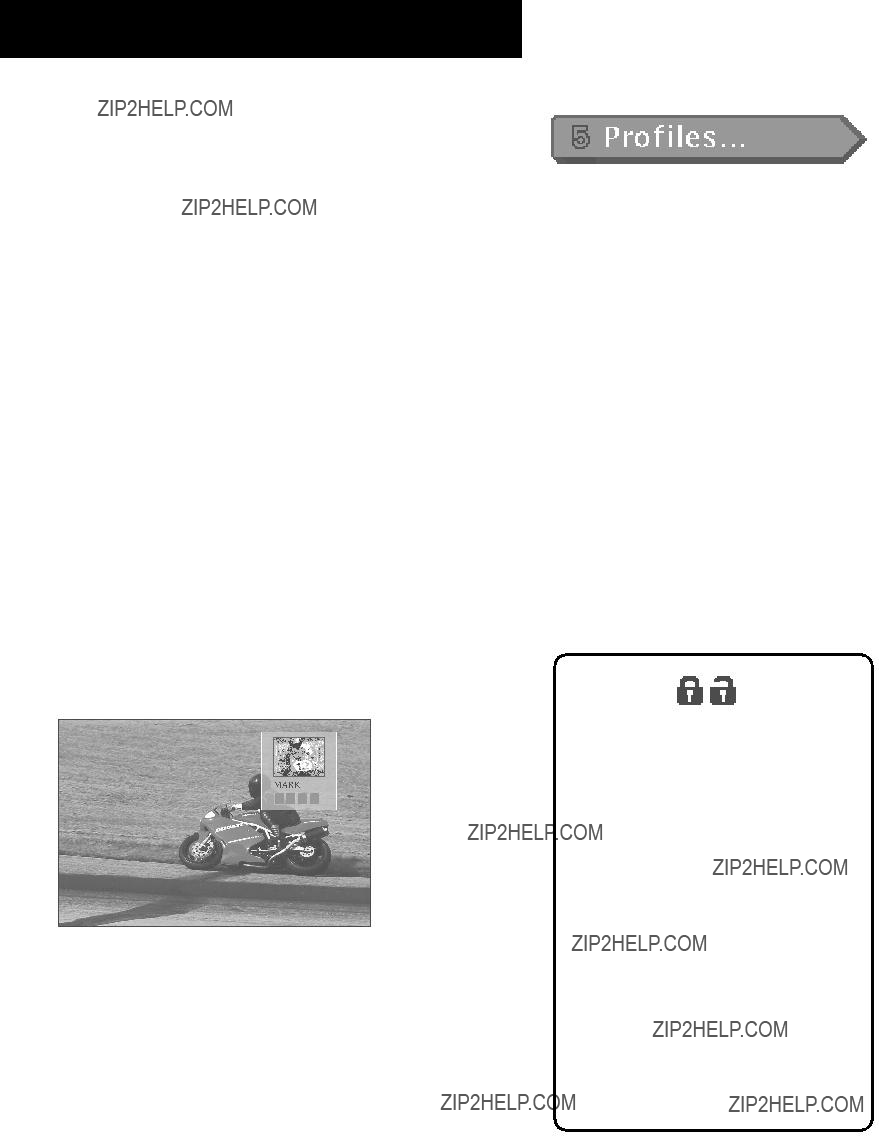
THE MENU SYSTEM
Unlocking the System
When the system is unlocked, the channel, spending, viewing, and ratings limits, that you have set are no longer in effect.
1.Point to Unlock System and press MENU???SELECT.
2.Point to Yes and press MENU???SELECT to confirm that you want to unlock the system.
Session Unlock
If your system is locked and you attempt to access a channel or program that is blocked by one or more limits, you are asked to enter the
If you enter the password to override the rating or spending limit, all limits are unlocked until you turn off the receiver. When you turn on the receiver again, the system will be locked, and the Family profile channel list will be selected. You can also
CHOOSING YOUR PROFILE
Each time that you turn on the receiver, the Family profile is selected by default. To select a different Profile:
1. Press the WHO???INPUT button to scroll through the profiles.
The WHO button toggles through the profiles.
2.When your profile appears, enter your
???If the profile is not password protected, you can just press MENU???SELECT to activate it.
The channel, spending, ratings and viewing limits will reflect the chosen profile only when the system is locked.
The Lock/Unlock icons in the channel banner provide an easy way to lock or unlock the system. Just point and select to change the lock status.
Green Unlock icon The system is unlocked. Spending, viewing and other limits can be accessed and changed.
Yellow Unlock icon A password has been entered to override family or profile limits. No limits can be accessed or changed.
Red Lock icon No limits can be accessed or changed. A password is required to override limits or access the system.
41

THE MENU SYSTEM
OPTIONS
The Options menu lets you set up preferences for the look and feel of the system as well as how some of the features work.
The Options menu lets you change how the system works.
The following sections explain your options when changing your personal preferences. Follow the
Interactive Setup
If you
System Info
Select System Info from the Options menu to choose from a list of
Program Guide shows a
Menu System shows a
Remote Control shows an
42

THE MENU SYSTEM
Front Panel shows an
Back Panel shows an
Glossary shows a list of common satellite system and TV terms. Point to a glossary item to see a brief description.
LOOK AND FEEL
Default Guide lets you choose which guide appears first when you press the GUIDE button on the remote. The choices are Grid Guide, Detail Guide and SurfGuide.
Color Scheme lets you pick which color appears in the guides and menu system.
Translucency lets you choose the translucency of the menu displays. Slide the indicator bar to make the screens more opaque or less opaque.
Animation lets you turn animation on or off. Animation appears
SYSTEM OPTIONS
System Test The System Test display screen is accessed through the Options menu, and allows you to initiate diagnostic procedures on the satellite system. You should use this feature to get your Access Card number, or when your receiver doesn???t seem to be working correctly. There are four separate tests: signal, tuning, phone connection, and access card.
A message screen appears, telling you whether the system passed each test. If your system fails a test, run the system test several times before concluding that there is a problem. Occasional fluctuations in the phone line or satellite signal can give temporary false readings.
43

THE MENU SYSTEM
New Access Card Periodically, your program provider may issue you a replacement access card. The New Access Card Setup display screen allows you to transfer the information from the old card onto the new one.
Follow the display screen prompts to initialize your new card. Once you have transferred the information to the new card, your old card becomes invalid.
Because your specific account information is stored in the access card, power failures should have no effect on your system.
Remote Setup Some remotes have two SAT buttons and can control two digital satellite receivers. Choose which remote button, SAT1 or SAT2, will control the receiver.
Picture Size The Picture size display screen allows you to choose between a standard TV screen and a Cinema option. A standard TV screen has an aspect ratio of 4:3; the Cinema option has an aspect ratio of 16:9.
Data Port Let???s you choose whether the low speed data port is used for low speed data or communicating with the Home Control Base accessory. See the Home Control section in this book for more information.
AUDIO LANGUAGE
When you select Audio Language from the Options menu, the Audio Language display screen comes up.
Point to the audio language or audio type you want and press MENU???SELECT. The system will then automatically set the audio program to the selected audio program type when that type is available.
There are two ways to change the audio:
???Press ALT AUD on the remote to temporarily change the Audio program while tuned to the current channel.
???Point to Audio Language from the Options menu and press MENU???SELECT to set the default Audio Language.
ALTERNATE DATA
Selects from among the available data on the current channel.
44
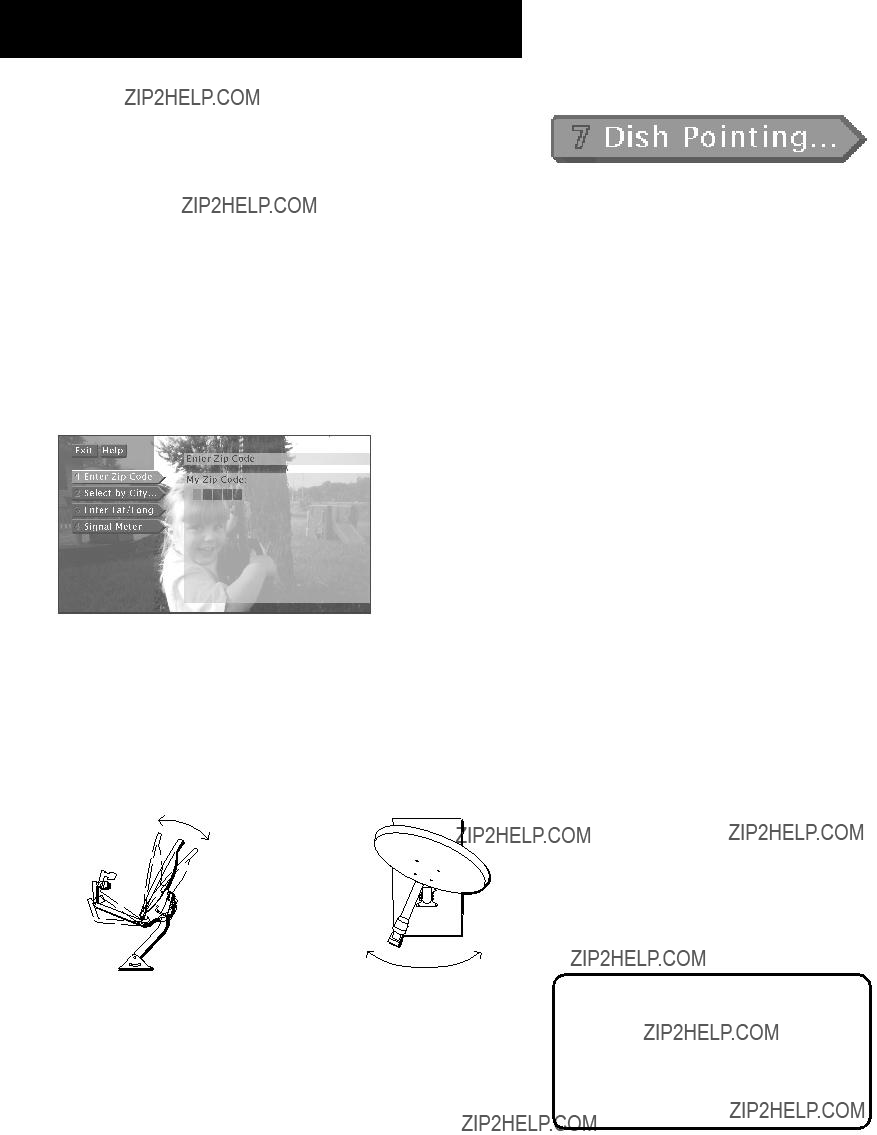
THE MENU SYSTEM
THE DISH POINTING MENU SCREEN
Follow these steps to obtain your dish pointing coordinates:
1.Turn on your television and satellite receiver.
2.Tune your television to the satellite receiver???s output channel.
3.Press MENU???SELECT on the remote or front panel to bring up the Main menu.
4.Use the arrows to highlight the ???Dish Pointing??? option, and then press MENU???SELECT to access the dish pointing screen.
NOTE: The menu screen that you see may be slightly different from the one pictured here.
5.Use the arrows on the remote or the front panel to highlight ???Zip Code??? and then press MENU???SELECT.
6.Enter the zip code for the dish installation location.
7.Record the elevation and azimuth numbers below.
Elevation is the up/ down angle that the dish is pointed.
Azimuth is side to side direction that the dish is pointed.
You only need to use one of the available methods to find your dish pointing coordinates. If you know the zip code for the locality where the dish is being installed, use that.
45
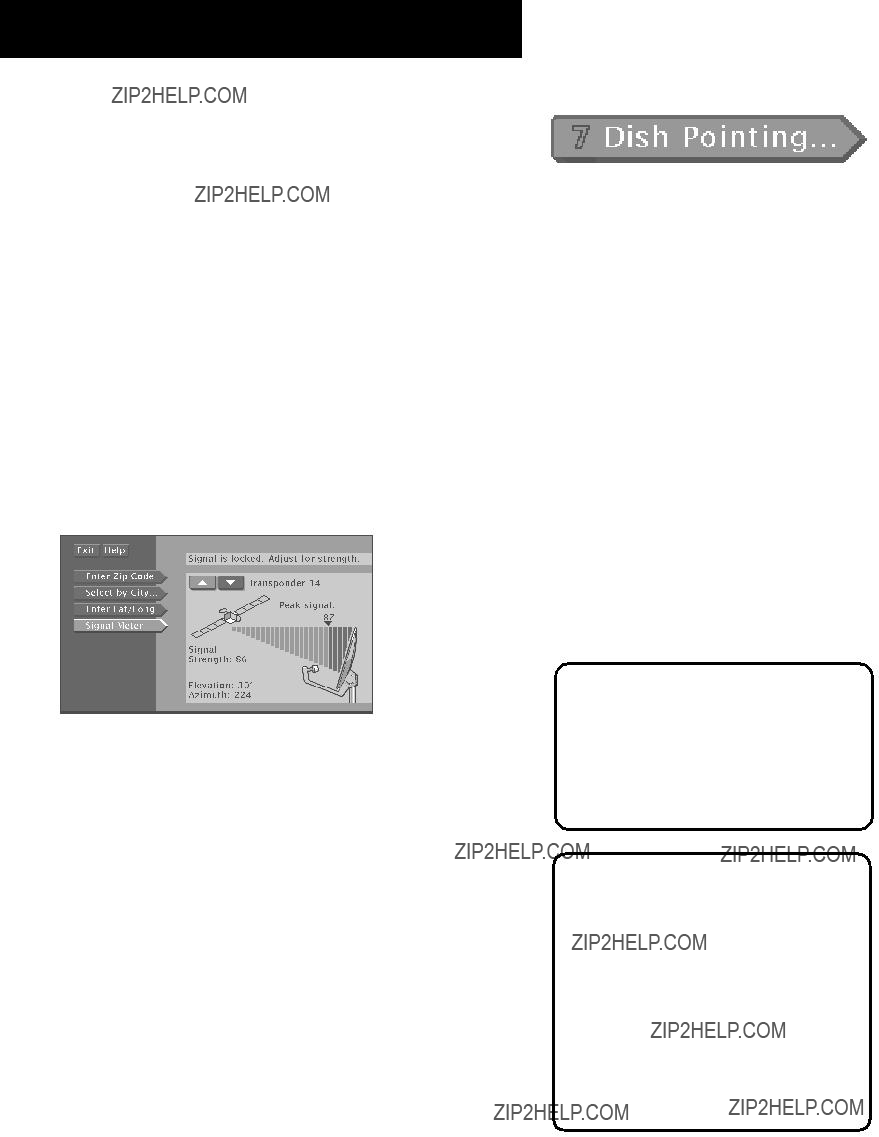
THE MENU SYSTEM
USING THE
The signal strength meter is used to determine whether or not you are receiving the satellite signal, and it also indicates the strength of the satellite signal.
Follow these steps to bring up the
1.Turn on your television and satellite receiver.
2.Tune your television to the satellite receiver???s output channel.
3.Press MENU???SELECT on the remote or front panel to bring up the Main menu.
4.Use the arrows to highlight the ???Dish Pointing??? option, and then press MENU???SELECT to access the dish pointing screen.
5.Use the arrows on the remote or the front panel to highlight ???Signal Meter??? and then press MENU???SELECT.
If the dish is pointed to the correct azimuth and elevation, the signal meter will show you the current signal strength (and you should hear a continuous tone).
If you are not receiving a signal, you need to incrementally adjust the azimuth setting on the dish. After you receive a signal, you will want to continue to adjust the azimuth to try to get the best possible signal.
Important
Changing transponders is not the same as
Peak Signal
The ???Peak Signal??? indicates the highest signal strength you have obtained, which is not necessarily the highest possible signal.
While the maximum signal strength is 100, the signal strength you achieve will probably be less. Although there is no difference in picture quality between a signal strength of 60 and 85, the higher the signal, the less likely you are to experience negative effects in degraded conditions such as rain or snow (called ???rain fade???).
46
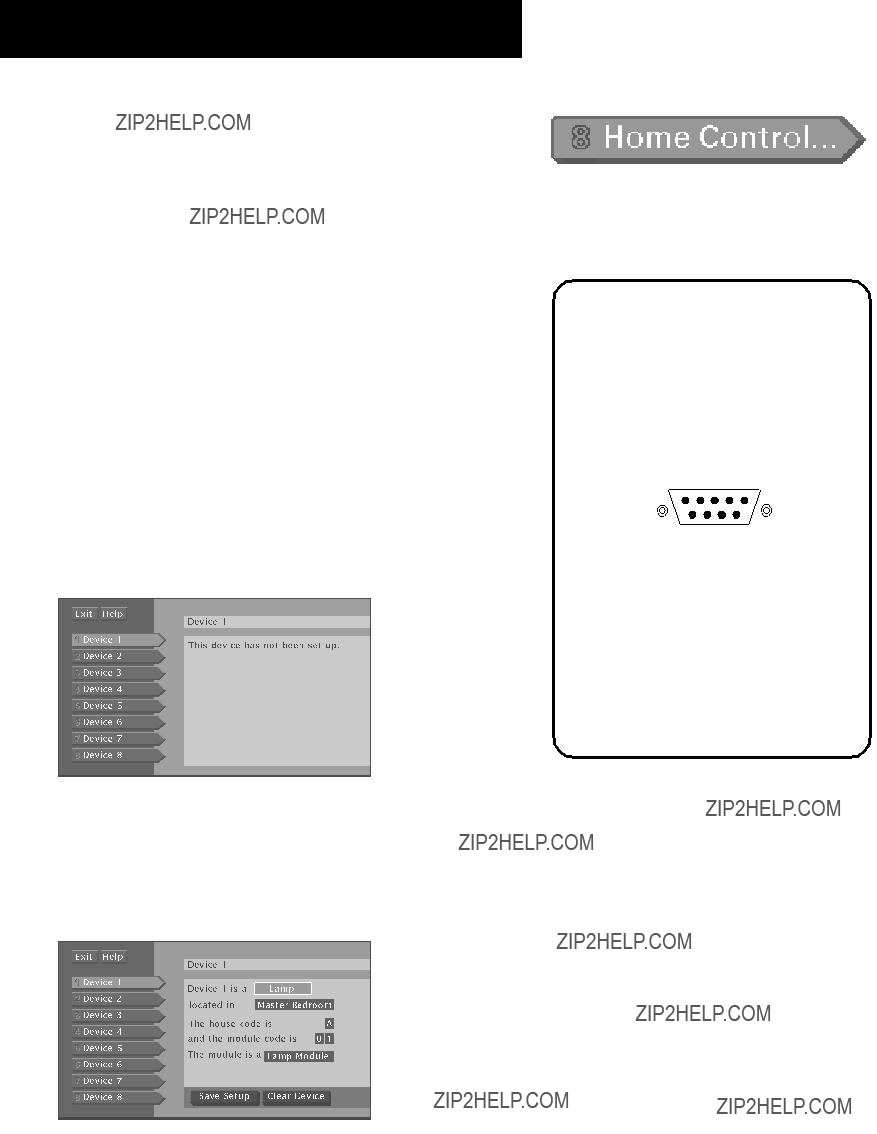
THE MENU SYSTEM
HOME CONTROL
Home Control lets you remotely control several lamps and appliances through your receiver.
Home Control setup
The Home Control Data Interface connects to the LOW SPEED DATA port on the back of the receiver. Once connected, you must tell the receiver to use this port for Home Control.
1.Press MENU???SELECT to bring up the Main menu.
2.Point to and select Options.
3.Point to and select System Options.
4.Point to and select Data Port and choose Home Control as the default setting
Device Setup
1. From the Main menu select Home Control.
Home Control can control several devices.
2.Select a device you would like to control.
3.Complete the
Keep track of devices by assigning a label.
To control devices, you must connect a Home Control Data Interface to the receiver and a remote module to the device you want to control. The Home Control Data Interface connects to the LOW SPEED DATA port on the back of the receiver.
LOW SPEED DATA PORT
Once connected, you must tell the receiver to use this port for Home Control.
These devices are available as accessories sold through your digital satellite dealer or the accessories order form at the back of this book.
47
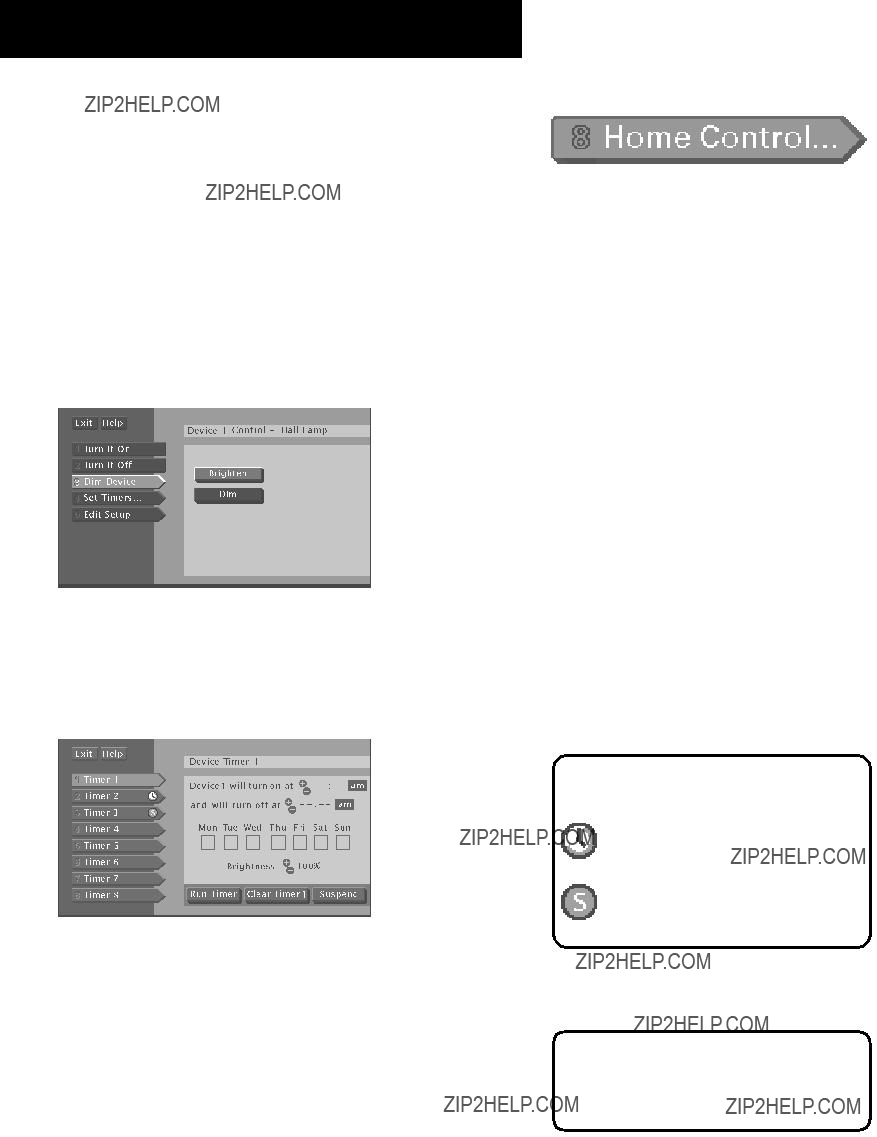
THE MENU SYSTEM
4.Use the arrow buttons and MENU???SELECT to select the house and module codes that match the device???s remote module and label the module. Select Save Setup to complete the setup.
Device Control
Once the device is set up, there are two ways to control it; with the menu system, or with a timer. Select a device from the Home Control menu screen. You can then, turn it on, turn it off, or adjust the brightness for lamp modules.
Select Edit Setup to change a device.
Control the device from the menu.
To schedule a timer:
1.Select Set Timer.
2.Schedule a timer by completing the
Complete the
3.Use the arrows and MENU???SELECT to enter an on and off time.
4.Point to and select Run Timer.
Clear Timer removes all the timer information.
Suspend turns off the timer, but saves the timer information.
indicates the timer is set.
indicates the timer is suspended.
You can schedule several timers to control the same device at different times.
48
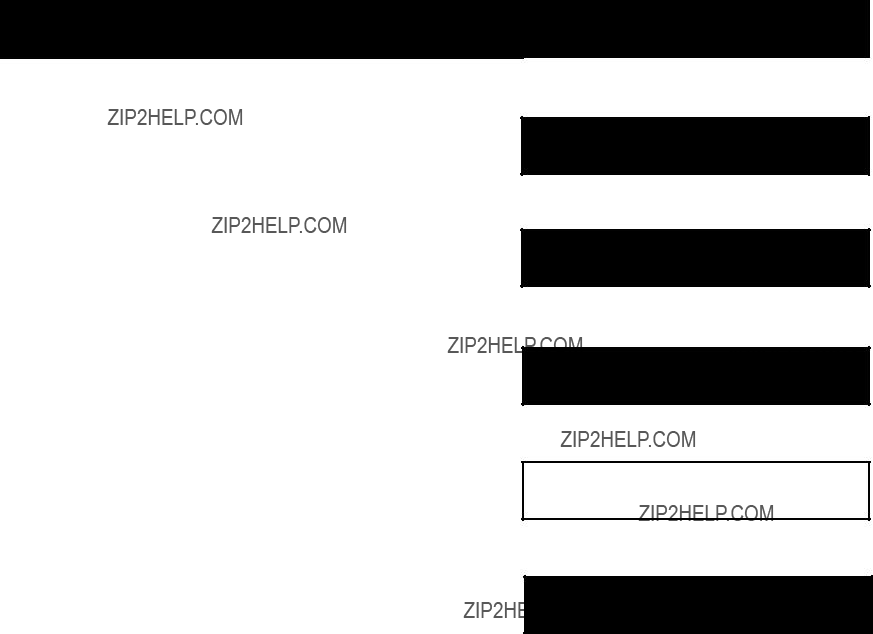
REFERENCE
HOW IT ALL WORKS
Although the digital satellite system is simple to use, there are a number of parts in the system. Don???t be overwhelmed. This section explains how these different parts work together to bring a picture to your screen.
WHAT???S IT FOR?
This section also describes the controls located on the front and back of the receiver.
1 FIRST THINGS FIRST
???
2 PROGRAM GUIDES
???
3 THE MENU SYSTEM
???
4 REFERENCE
???
5 APPENDICES
49
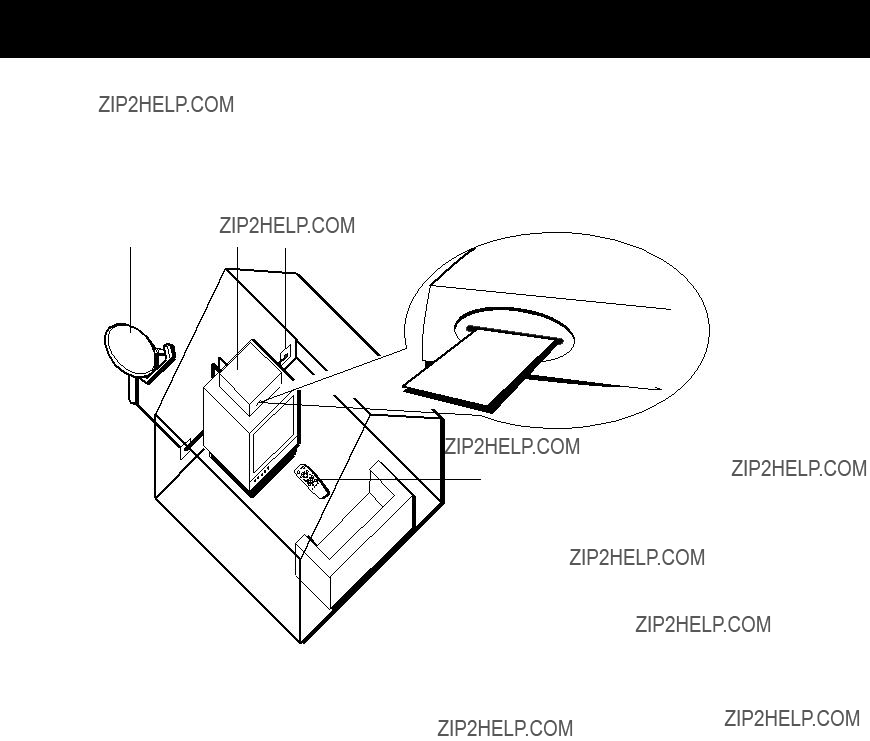
REFERENCE
HOME VIEW
These parts are inside of or attached to your house.
Access Card
Remote Control
Satellite Dish Antenna Picks up the satellite???s coded program information and relays it to your receiver. (Your satellite dish may be installed in different locations on or around your house. The satellite dish antenna must, however, be pointed in a southern direction toward the satellite.)
Digital Satellite Receiver Receives the TV program information and sends it to your TV or VCR.
Telephone Jack Connects to the phone jack on the back of the receiver. The receiver uses a
Television If your television is remote controllable, you can program the remote to change channels and volume.
Remote (included with your satellite system) Controls the system as well as most remote controllable TVs. Point the remote at the device you want to control.
Access Card (installed in receiver) Must be inserted for you to use the system! Provides system security and authorization of program services. Do not remove the card except when issued a new card as a replacement for the original.
50
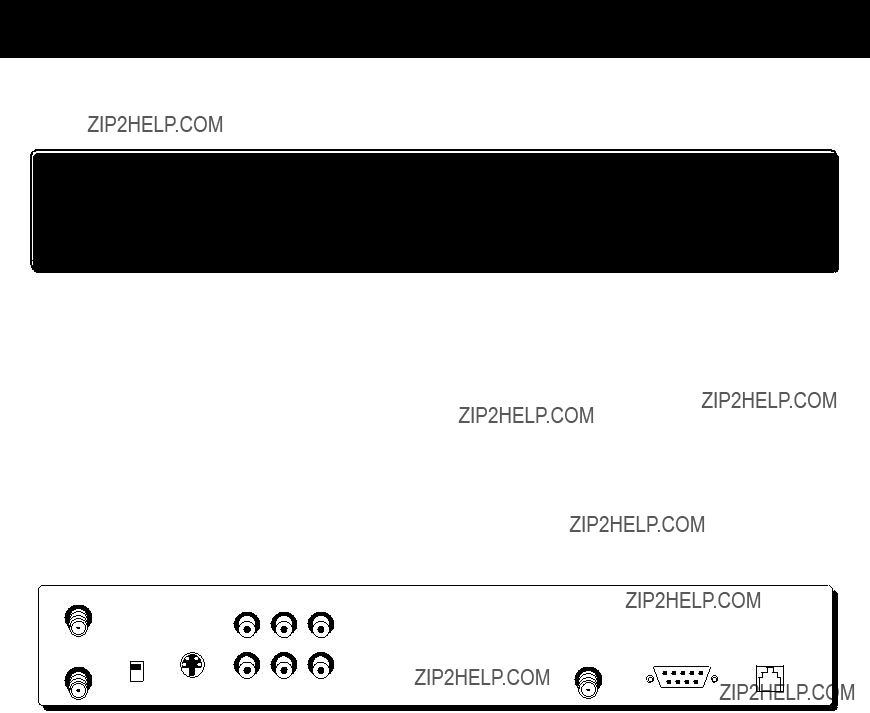
REFERENCE
FRONT PANEL CONTROLS
ON/OFF Turns the receiver???s power on or off.
INFO Brings up the
ANTENNA Switches the source of the video signal from satellite signals to an
ARROWS Press the navigation arrows to move the
MENU???SELECT Brings up the Main menu. If you are already in the menu system, press MENU???SELECT to select a highlighted choice.
ACCESS CARD Identifies you to your program providers. The system requires a valid access card.
BACK PANEL CONTROLS
OUT
TO
TV
IN
CH 4
CH 3
FROM
ANT
OUT TO TV Use to connect the receiver to your TV. However, if your TV has audio/video jacks, you should use those jacks to get better picture and sound quality.
IN FROM ANT Use to connect an
CH3/CH4 SWITCH If a coaxial cable is used to connect the receiver to your TV, you must set the CH3/CH4 SWITCH. For example, to see the signal on TV channel 3, set the switch to 3.
VIDEO Provides better picture quality than the OUT TO TV jack. If your TV has audio/video capability, use this jack to connect the receiver to your TV. You must also connect the AUDIO jacks.
AUDIO (R and L) Provide better sound quality than the OUT TO TV jack. If your TV has audio/video capability, use these jacks to connect the receiver to your TV. You must also connect the VIDEO jack.
SATELLITE IN Use to connect the receiver to the satellite dish antenna.
LOW SPEED DATA PORT this port allows you to connect the system to accessories, such as the Home Control base module.
PHONE JACK Use to connect a phone line to the receiver. The system requires a phone line connection to periodically call out to program providers.
51
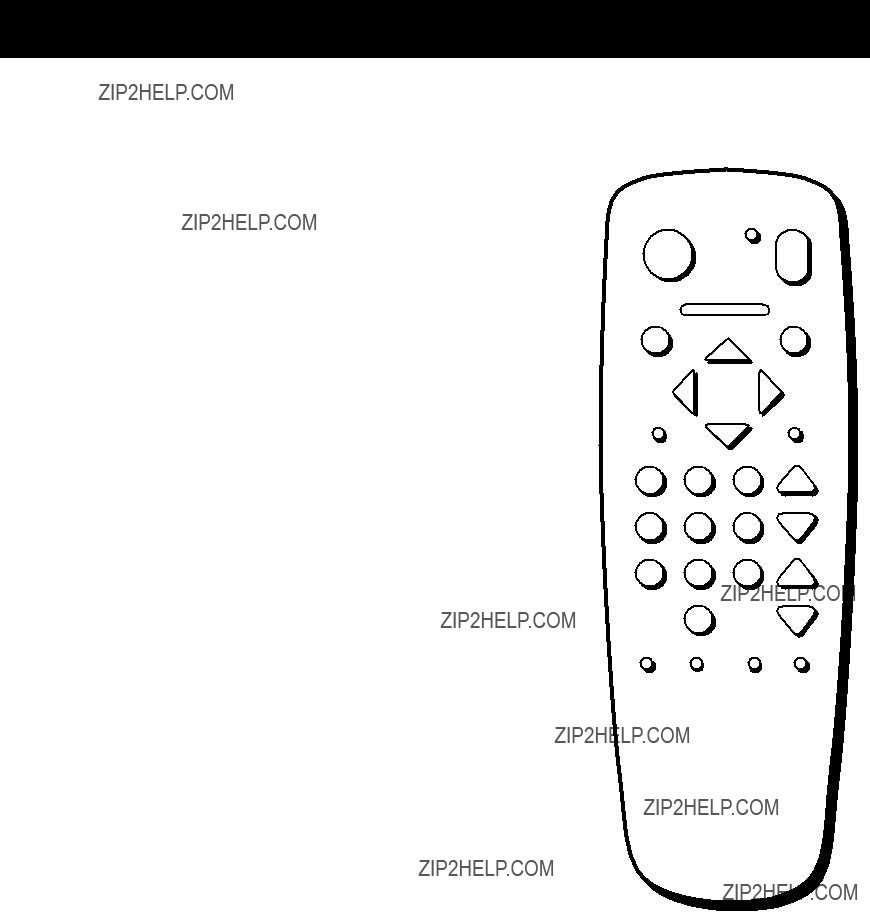
REFERENCE
REMOTE CONTROL BUTTONS
ON???OFF Turns the device you are controlling on or off.
TV Tells the remote to control the TV.
SAT Turns on the receiver and tells the remote to control system functions.
GUIDE Brings up the
MENU???SELECT Brings up the Main menu. If you are already in the menu system, press MENU???SELECT to select a highlighted choice.
ARROWS Use the navigation arrows to move the
INFO Brings up the
CLEAR Removes the on screen displays and return to normal viewing.
GO BACK Moves you back and forth between your last two selected channels. In the menu system, returns you to the previous screen.
DIGIT KEYS (0 - 9) Use the digit keys to tune directly to a channel. If you are in the menu system, use the digit keys to enter numbers for the time, date, channel and passwords.
CHAN UP/DOWN Use to scan up and down through the channels in the current channel list. If you are in the program guide or menu system, use the CHAN UP/DOWN buttons to page up and down a screen at a time.
VOL UP/DOWN Adjusts the audio volume.
ANT Lets you switch the source of the video signal from satellite signals to an
ALT AUD (Alternate Audio) Use to toggle through the available languages or audio types for a program.
MUTE Turns off the sound. Press again to restore the sound.
MENU???SELECT
GUIDE  INFO
INFO
52
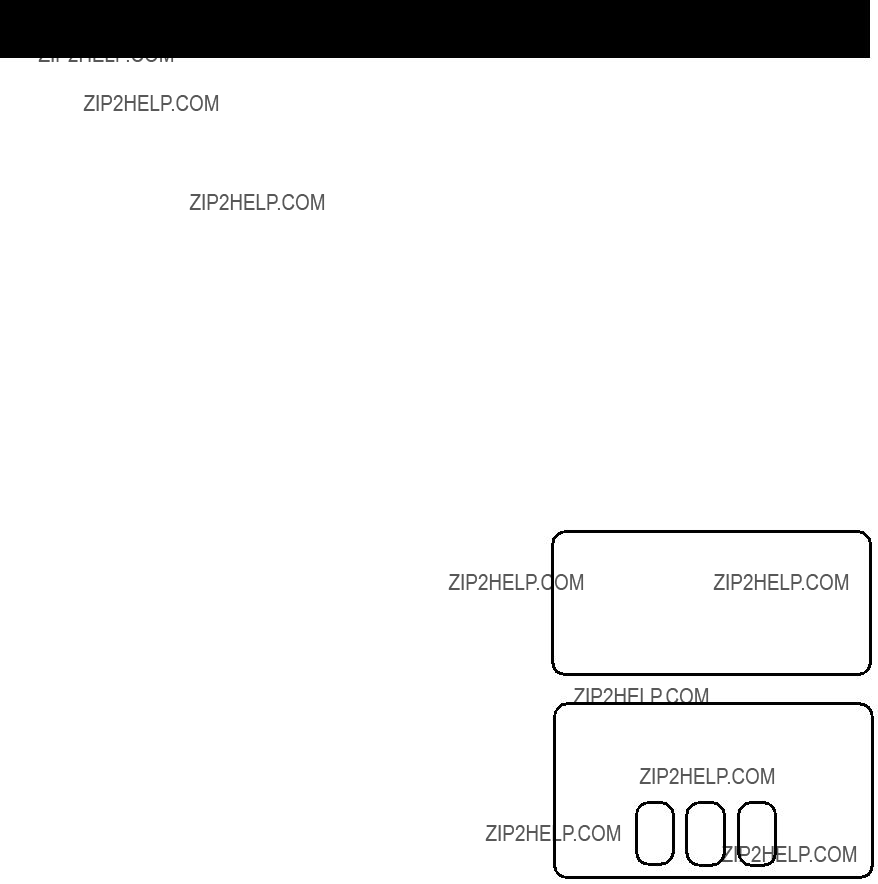
REFERENCE
PROGRAMMING THE REMOTE CONTROL
The remote can be programmed to control most brands of remote controllable TVs. The remote is programmed to control most RCA, GE and ProScan TVs. The remote needs to be programmed to control other manufacturers??? brands.
PROGRAMMING THE REMOTE TO CONTROL
YOUR TV
To determine whether your remote needs to be programmed, turn the TV on, point the remote at the TV, and press the TV button. Then press CHAN UP or DOWN to see whether the TV responds to the remote commands.
Follow these steps to program your remote to control your TV.
1.Turn on the TV.
2.Look up your brand and code number(s) on the TV Code list on the following pages.
3.Press and hold the TV button.
4.Enter the
5.Release the TV button and press OFF???ON or CHAN UP/DOWN to see if the TV responds to the remote commands. If it doesn???t, try the next code listed for your brand.
6.Repeat these steps until the TV responds to the remote commands.
Using the Remote Buttons to Control a Device
Once the remote has been programmed with the correct codes, you are ready to use it to control your devices.
To operate the device:
1.Press the device button (TV, SAT) to set the remote to control the device.
2.Press OFF???ON to turn the device off or on.
3.Use the remote buttons that apply to that device.
This remote may not operate all models of the brands that are shown. Use the codes shown in this manual, or on the sheet packed with your remote.
After you program the remote to control your TV, record your TV code here for easy reference.
53
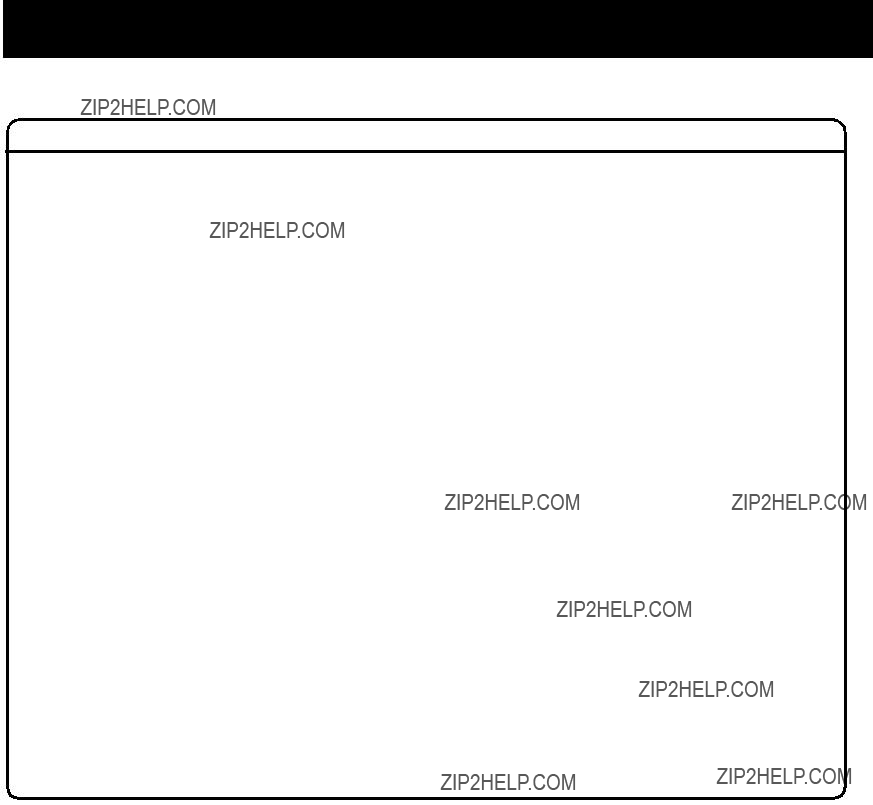
REFERENCE
Remote TV Codes
TROUBLESHOOTING
The System Test allows you to run a basic diagnostics check on your digital satellite system. If you are experiencing any trouble with your system, bring up the Main menu, select Options, then System Options and run the system test.
Make sure that
???All
???There are batteries in the remote, and that they are working correctly.
???The access card is installed in the receiver.
54

APPENDIX A: WARRANTY INFORMATION
Repair Help
Thomson Consumer Electronics offers hardware repair service should you encounter any problems with your digital satellite system. Many problems can be diagnosed over the phone, or if necessary, a replacement unit can be shipped to you. Please have your digital satellite system model, serial number and date of purchase ready when you call. If your unit is out of warranty, we will quote the cost of an exchange unit to you. Refer to RCA Digital Satellite System Limited Warranty for the repair service phone number.
Returning Equipment to Thomson for Repair or Exchange
If we are unable to resolve your problem over the phone we will gladly service your unit or exchange it for a new or refurbished unit. Refer to the limited warranty included in the booklet to learn about your specific rights and responsibilities. Always consult Thomson and get a Return Authorization number before returning anything. Obtain a Return Authorization (RA) number from the telephone representative before returning your equipment to avoid delays, accounting errors, or even loss of your unit.
Important Information to Customers Who Ship Defective Equipment to Thomson Consumer Electronics
The Thomson representative who authorizes the return of your equipment will give you an RA number over the phone. The representative will also provide you with instructions on where and how to return your unit. Write the number in large, clear characters on the outside of the box. To avoid confusion and misunderstandings, shipments without an RA number clearly visible on the outside of the box will be returned to you at your expense.
Include a brief note describing the problem and any conversations you have had with Thomson personnel about the problem. Include your name, address and model/serial number of your unit. These numbers are located on the back of your receiver. If your digital satellite system is within the warranty period, please provide a copy of the bill of sale to verify purchase date. Use the original box and packing material to protect the equipment from damage in shipment. For your protection, insure all shipments for full replacement value and use a reliable shipper. Thomson assumes no responsibility for warranty shipments from the customer to the factory if not shipped in the manner prescribed by Thomson.
55

APPENDIX A: WARRANTY INFORMATION
RCA DIGITAL SATELLITE SYSTEM LIMITED WARRANTY
What your warranty covers:
???Any defect in materials or workmanship.
For how long after your purchase:
???90 days - Unit exchange, which includes parts and labor.
???91 days to 1 year - Unit exchange, which includes parts only; you pay the labor.
???The warranty for rental units begins with the first rental or 45 days from date of shipment to the rental firm, whichever comes first.
What we will do:
???During the initial 90 days:
Exchange the defective portion of your digital satellite system with a new or, at our option, refurbished unit.
???After the 90 days and within one year:
Exchange the defective portion of your digital satellite system with a new or, at our option, refurbished unit. We will charge you a flat exchange cost to replace a defective receiver. This charge covers the labor cost for its repair.
How you get service:
???Call
???A representative will troubleshoot your problem over the phone.
???If the representative determines that you should receive a replacement receiver you will be provided with a Return Authorization (RA) number and the location of a nearby exchange point if one exists. No returns will be accepted without the RA number.
???If the representative determines that your antenna/dish is defective he or she will arrange for its repair or replacement.
To receive a replacement receiver before you return yours:
If you are located near an exchange point:
1.We will send a replacement unit to our exchange point.
2.The exchange location will notify you of its arrival.
3.Take your unit and evidence of purchase date, such as a bill of sale, to the exchange location and you will be provided the new or refurbished unit. Please retain all accessories such as the remote control hand unit.
4.If the repairs are covered by your warranty, you will not be billed.
If you are not located near an exchange point:
1.Provide your Discover, Mastercard or Visa account number and expiration date to your phone representative. This is for security purposes only and your account will not be charged at this time.
2.We will send you a replacement unit.
3.If you return the unit to us within 14 days from the date you were provided a RA number, only items not covered by warranty will be charged to your account. If your unit is not received within 14 days, the suggested retail value of the receiver will be charged to your credit card. This amount will be credited if the unit is subsequently received.
4.Ship your defective unit back to us using the replacement unit???s carton. Shipping instructions will be included on the carton along with your RA number which will allow you to easily ship the unit back to us. Make sure you insure your shipment in case of damage or loss. Include with the shipment:
???Evidence of purchase date such as a bill of sale.
???A brief note describing your receiver problem.
???Your name, address and phone number.
Thomson assumes no responsibility of warranty shipments from the customer to the factory if not shipped in the manner prescribed by Thomson.
56

APPENDIX A: WARRANTY INFORMATION
To receive a replacement receiver after we have received your unit:
???Write the RA number on the outside of the carton used to return the unit. Make sure you insure your shipment in case of damage or loss.
???Carefully pack the unit using the original box and packing material if possible. Please retain all accessories that were included with your unit such as the remote control hand unit.
???Include with the shipment:
1.Evidence of purchase date such as a bill of sale.
2.A brief note describing your receiver problem.
3.Your name, address and phone number.
???The representative will advise the address to mail a cashier???s check or money order for payment if there are any out of warranty labor or parts charges, and you elect not to use your credit card.
???After we receive your product, a new or refurbished unit will be shipped to you.
What your warranty does not cover:
???Acts of God, such as but not limited to lightning damage.
???Adjustment of customer controls.
???Damage from misuse or neglect.
???A unit that has been modified or incorporated into other products or is used for institutional or other commercial purposes.
???Batteries.
???Units purchased, serviced or operated outside the continental U.S.A. and Alaska.
???For units intended for use in Alaska, this warranty does not cover installation or the dish antenna. It only covers the receiver.
???Loss of programming.
???Installation.
???Shipping damage if the unit was not packed and shipped in the manner prescribed by Thomson.
???Storage fees may be charged by the exchange point if you fail to pickup the replacement unit in a timely manner.
Product Registration:
???Please complete and mail the Product Registration Card packed with your digital satellite product. It will make it easier to contact you should it ever be necessary. The return of the card is not required for a warranty coverage.
How state law relates to warranty:
???This warranty gives you specific legal rights and you may have other rights that vary from state to state.
If you purchased your product outside the United States:
???This warranty does not apply. See your dealer for warranty information.
57

APPENDIX B: FCC REGULATIONS
FCC Registration Information
Your digital satellite system equipment is registered with the Federal Communications Commission and is in compliance with parts 15B and 68, FCC Rules and Regulations.
1. Notification to the Local Telephone Company.
On the bottom of this equipment is a label indicating among other information, the FCC Registration number and Ringer Equivalence Number (REN) for the equipment. You must, upon request, provide this information to your telephone company.
-
The REN is useful to determine the number of devices you may connect to your telephone line and still have all these devices ring when your telephone number is called. In most (but not all) areas, the sum of the RENs of all devices connected to one line should not exceed 5. To be certain of the number of devices you may connect to your line as determined by the REN, you should contact your local telephone company.
Notes: This equipment may not be used on coin service provided by the telephone company.
Party lines are subject to state tariffs, and therefore, you may not be able to use your own telephone equipment if you are on a party line. Check with your local telephone company.
Notice must be given to the telephone company upon permanent disconnection of your digital satellite system equipment from your line.
2. Rights of the Telephone Company.
Should your equipment cause trouble on your line which may harm the telephone network, the telephone company shall, where practicable, notify you that temporary discontinuance of service may be required. Where prior notice is not practicable and the circumstances warrant such action, the telephone company may temporarily discontinue service immediately. In case of such temporary discontinuance, the telephone company must: (1) promptly notify you of such temporary discontinuance (2) afford you the opportunity to correct the situation and (3) inform you of your right to bring a complaint to the Commission pursuant to procedures set forth in Subpart E of Part 68, FCC Rules and Regulations.
The telephone company may make changes in its communications facilities, equipment, operations of procedures where such action is required in the operation of its business and not inconsistent with FCC Rules and Regulations. If these changes are expected to affect the use or performance of your telephone equipment, the telephone company must give you adequate notice, in writing, to allow you to maintain uninterrupted service.
Radio Interference
This equipment has been type tested and found to comply with the limits for a Class B Digital Device in accordance with the specifications in Part 15 of FCC Rules. These rules are designed to provide reasonable protection against radio and television interference in a residential installation. This equipment generates, uses and can radiate radio frequency energy and, if not installed and used in accordance with the instructions, may cause harmful interference to radio communications. However, there is no guarantee that interference will not occur in a particular installation.
If this equipment does cause interference to radio or television reception (which you can determine by turning the equipment off and on), try to correct the interference by one or more of the following measures.
???Reorient or relocate the receiving antenna (that is, the antenna for radio or television that is ???receiving??? the interference).
???Change the position of the satellite receiver with respect to the radio or television equipment that is receiving interference.
???Move the satellite receiver away from the equipment that is receiving interference.
???Plug the satellite receiver into a different wall outlet so that the satellite receiver and the equipment receiving interference are on different branch circuits.
If these measures do not eliminate the interference, please consult your dealer or an experienced radio/television technician for additional suggestions. Also, the Federal Communications Commission has prepared a helpful booklet, ???How To Identify and Resolve Radio/TV Interference Problems???. This booklet is available from the U.S. Government Printing Office, Washington, D.C. 20402. Please specify stock number
58
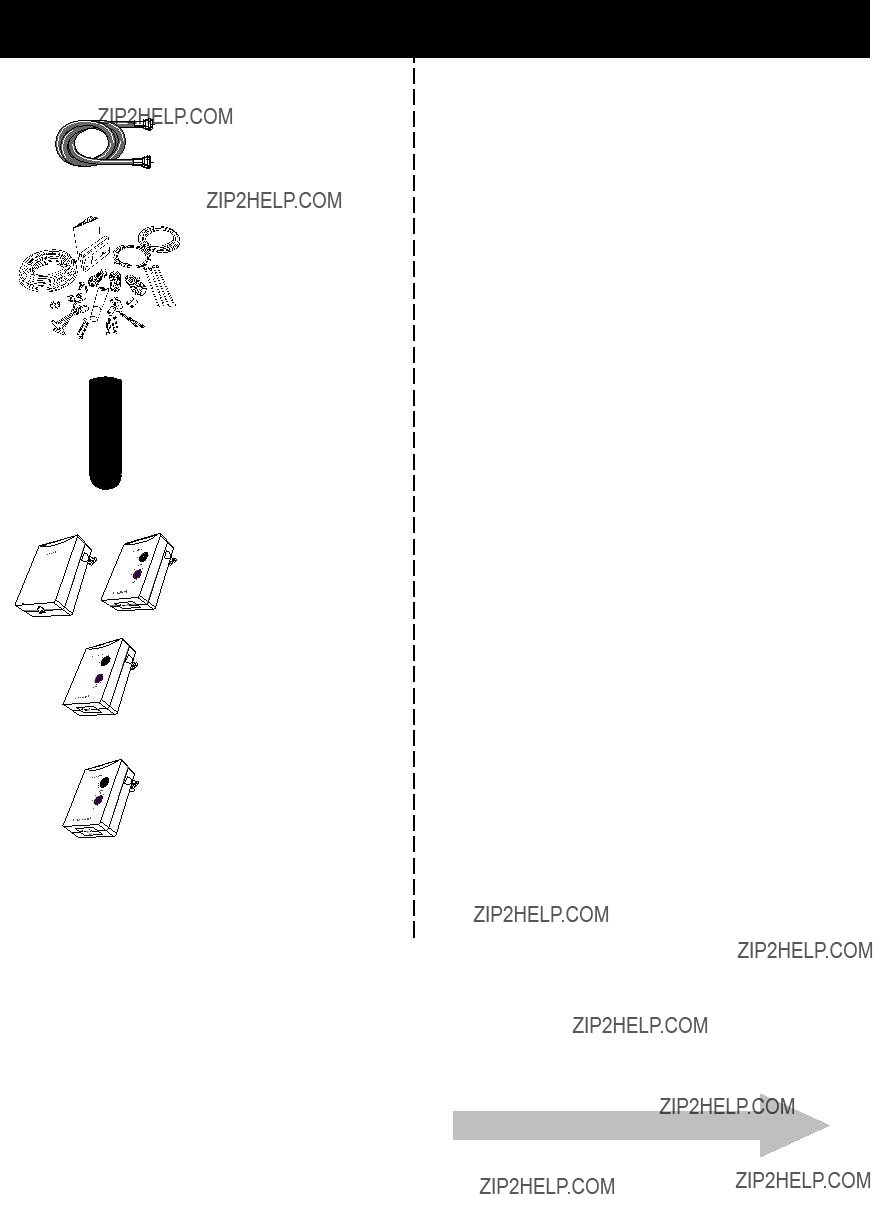
APPENDIX C: ACCESSORIES
Remote Control replaces a lost remote. Or, order a second remote for convenience.
HCDSS10 Home Control Kit contains a Data Interface that connects to the receiver, and a lamp module.
HC10LM Lamp module lets you control incandescent lamps. Use to dim/brighten and turn lamps on/off.
HC20AM or HC30AM Appliance modules turn small appliances, like coffee pots, popcorn makers, or stereo, on or off. Also controls non- incandescent lamps Choose 2 prong (HC20AM) or 3 prong (HC30AM).
Accessory Order Form for Digital Satellite Systems
All accessories are subject to availability.
Please complete other side also
59
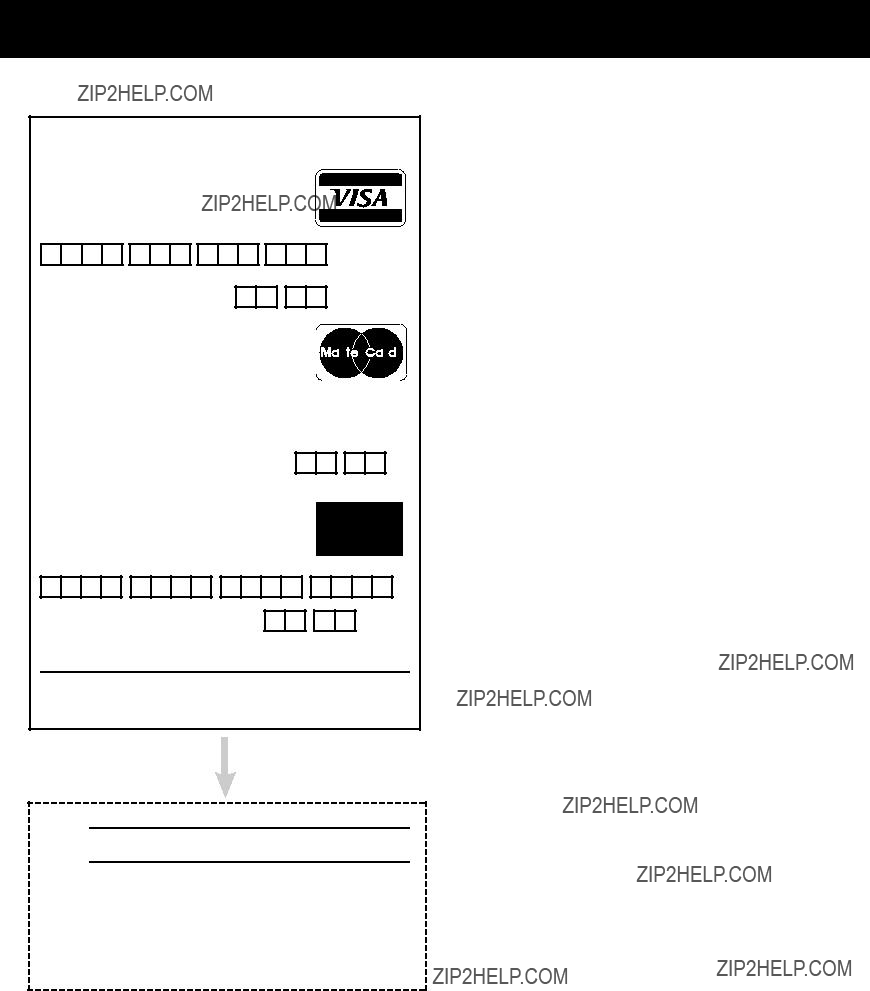
APPENDIX C: ACCESSORIES
Charge your order on your VISA, MasterCard, or Discover Card by filling in below
USE YOUR CREDIT CARD
??
IMPORTANT: Copy complete account number from your VISA card
My card expires:
IMPORTANT: Copy complete account number from your Discover Card
My card expires:
AUTHORIZED SIGNATURE
(Credit card order will not be processed without signature)
Prices are subject to change without notice.
Name:
Street:
Please make sure that both sides of this form have been filled out completely.
???Allow 4 weeks for delivery.
???All accessories are subject to availability. ???
???Prices are subject to change
United States and Canada Orders
To place your order by phone, have your Visa, MasterCard or Discover Card ready and call the
Use this number only to place on order for accessory items listed on this order form.
To place your order by mail, detach and mail the completed order form with credit card information, money order or check in US currency (made payable to Thomson Consumer Electronics, Inc.) to the following address:
Video Accessories
PO Box 8419
Ronks, PA 17573
60

INDEX
A
Access card 50 number 14 Accessories 59 All button 22
AlphaSort button 23 Alternative data 44 Attractions Guide 20, 34 Audio Language 44
B
Batteries
installing in the remote 5
Buttons 52
C
Cancelling purchases 35 Channel banner
Channel Guide 20 Channel lists 37
add channels 38 delete channels 38
Connections 8 audio/video quality
10, 11, 12, 13 jacks and cables 9
D
Data port 17 Default guide 18 Detail Guide 18
DIRECTV programming 14 Dish Pointing 45
azimuth 45 elevation 45 menu 29
E
Exiting
menus 28, 29 program guides 20, 26
F
Front panel controls 51
G
Grid Guide 18
GUIDE button 18
Guides. See Program guides
H
accessories 59 icon 17 menu 29 setup 47 timers 48
I
Icons 17, 36, 40, 48 Interactive setup 14, 42
L
Locking
a profile 40
the system 17, 37, 40 Logo Guide 20
Look and feel 43
M
Mailbox
checking your mail 31 deleting mail 31
icon 17
Main menu 26, 27, 31 Menu system 4
icons 36, 40, 48 navigation 7
Menus
Dish Pointing 29, 45 Home Control 29, 47 Mailbox 29, 31 Options 29, 42 Profiles 29, 37 Program Guide 29 Purchases 29
Timers 29, 36 Movies button 22
O
Options menu 29, 42 Other Guides
P
Passwords 40
tuning to 32 Profiles
channel lists 37 choosing 41 locking 40 menu 29, 37 ratings limits 38 spending limits 39 unlocking 41 viewing hours 39
Program guides 4, 15, 19 anatomy 16, 30 Attractions Guide 20 buttons 19
Detail Guide 18 exiting 20, 26 Grid Guide 18 help 26
Logo Guide 20 scrolling 18 sorting 21 SurfGuide 18
tuning to a program 19 Programming the Remote
cancelling 35 menu 29, 35 previewing 32 reviewing 35 spending limits 36
R
Ratings limit 38 Receiver
back panel 51 connecting 6 front panel 51 system 4
Remote control batteries 5 buttons 52 programming 5, 53 using the 53
Reviewing purchases 35
S
peak signal 46 Sorting
program guides 21 Sorting by
All button 22 AlphaSort button 23 Movies button 22 Other Guides button 25 Scout button 24
Sports button 22 Topics button 21 Spending limits 36, 39
Sports button 22 SurfGuide 18 System lock 40 System options 43 System unlock 41
T
Timer feature
editing or cancelling 36 Timers
Timers menu 29, 36 Topics button 21 Transponders 46 Troubleshooting 54 Tuning to a program 19
U
Unlocking
a profile 41
the system 17, 41 USSB programming 14
V
Viewing hours limit 39
W
Warranty information 56
61

If your satellite system needs service, please contact your dealer or the nearest Servicenter from the yellow pages. Please do not send any products to the Indianapolis address listed in this manual or on the carton. This will only add delays in service for your product.
10330 North Meridian Street
Indianapolis, IN 46290
??1998 Thomson Consumer Electronics, Inc.
Trademark(s)?? Registered
Marca(s) Registrada(s)
Printed in USA
TOCOM 15392420
The following materials were used in printing this publication:
100%
RECYCLED PAPER
MINIMUM 40% POST CONSUMER